
I suspect most people go to Europe to experience the classical culture: the paintings, the sculptures, the buildings. But I am not a big fan of museums; my sub-specie is aficionado musicali. I claim this title not from a vast range of musical experience (although as the late, great Oscar Treadwell would say, I do have big ears), but from the depth of my passion. I want my Waldstein performed with the ethereal precision of Alfred Brendel; I prefer the looser swing of Mingus' Paris recording of Peggy's Blue Skylight to the original; Howlin' Wolf's Sittin' On Top of The World, but Cream's Spoonful; and the more fluid Mangkenugaran school of Javanese Gamelan. Perhaps you get the idea.
So my goals in Europe were firmly established long before we made our first reservation: I wanted to visit Mozart, Bach and Wagner. Ever since I discovered Wagner's Ring in my early twenties I had wanted to go to Bayreuth. Of course it takes years to get tickets so I knew we could not attend the festival. But even so I wanted to tour the Festspielhaus and visit Wagner's grave. Naively, as it turned out, I hoped to hear Bach played on an organ that the composer himself once played. And as planning for our itinerary took shape, I found, and at Mary's urging seized, an opportunity to visit Mozart in a completely unexpected fashion: I bought a very expensive ticket to the Salzburg Festival's production of The Magic Flute, featuring the Vienna Philharmonic conducted by Ricardo Muti! Only one, because Mary is not the opera fan I am; to achieve parity, I owe her a ticket to the New York City Ballet (or perhaps one day, the Bolshoi?).
Our plane tickets had us flying into Munich* and out of Milan, so we decided early on to visit Neuschwanstein. Mary and I had been watching Rick Steves' shows and reading his travel books, and she wanted to visit Rothenburg ob der Tauber, the Austrian Alps, Florence, Siena and Assisi. We both looked forward to the Cinque Terra, and in addition to Salzburg, Leipzig and Bayreuth, I added Eisenach to the list so we could visit the Wartburg. Montepulciano sounded nice, and I had always wanted to see Venice... Concert and festival dates dictated some backtracking, but our itinerary was coming together.
* I've decided to use Anglicized place names where there is a choice, with apologies to their natives. While I've never understood why English-speakers can't say München instead of Munich, Milano instead of Milan, Firenza instead of Florence, Padova instead of Padua and Venezia instead of Venice, I (and my primary audience) for some reason find it a hard habit to break.In the beginning we thought of the trip as another road trip, where we have a list of towns to visit and sites to see, but no real idea where we would be staying each night. It soon became obvious that we couldn't do Europe that way. For one thing, it is far more expensive to drive a car than to take the trains: gas was around $8.00 a gallon. And Mary realized before I did that having hotel reservations booked in advance would save us a great deal of uncertainty in (literally) foreign situations. And so our trip took on the following shape:

- 3 nights in Munich
Mary's sister Carol and her husband Rick flew with us to Munich and joined us for many of our adventures there;- 1 night in Innsbruck
- 2 nights in Salzburg
- 2 nights in Rothenburg
- 1 night in Eisenach
- 2 nights in Leipzig
- 2 nights in Bayreuth
- 2 nights in Padua
- 1 night in Montepulciano
Carol and Rick met up with us again here, and the next day the cast grew to include Mary's sister Nancy, my sister Karen, and my son Richard, whom we affectionately referred to as "Lucy, Ethel and Little Ricky";- 7 nights in Chianti
After our week in Tuscany, Richard, Karen and Nancy flew home, but Carol and Rick stuck with us for our remaining adventures;- 2 nights in Corniglia
- 1 night in Milan
The red lines show our train travels (3167 km or 1980 miles, according to Deutsche Bahn), the blue our driving trips (1500 km or 935 miles in a Fiat Punto 5-speed diesel), and the green dots are places we stayed. The detour from Florence to Rome and back to Pisa was not in our original plans, but I'll tell that story when I come to it.
(original map courtesy The CIA World Factbook)
 Our trip would actually last 28 days, but of course you cross 6 time zones as you fly east. So with a layover in Atlanta and a 10 hour
flight to Munich, we left our house around 8:00 AM on one day and arrived in Munich about 8:00 AM the next. And the last
day ended in Cincinnati, so we only had 26 nights to worry about. But how do you pack for 4 weeks in Europe?
Our trip would actually last 28 days, but of course you cross 6 time zones as you fly east. So with a layover in Atlanta and a 10 hour
flight to Munich, we left our house around 8:00 AM on one day and arrived in Munich about 8:00 AM the next. And the last
day ended in Cincinnati, so we only had 26 nights to worry about. But how do you pack for 4 weeks in Europe?
The answer is, you take Rick Steves' advice, and pack light. Here is all you need:
With 10 days of train travel, I didn't want to be lugging a lot of luggage on and off trains, so after a bit of hunting I found
a great backpack at TravelSmith. It held 3 mesh bags which made organization easy: in one went
2 extra shirts and 1 pair of pants, 3 extra pairs each of underwear and socks, 3 extra handkerchiefs, a swimming suit and a tee shirt.
All were quick-drying synthetics, so that washing clothes in the sink or shower would be practical in hotels when we were
staying 2 or more days. In another mesh bag went all the vitamins, prescription medicines and pain relievers that keep me alive,
and in the third went other toiletries. I also managed to fit a lightweight water resistant windbreaker in the backpack, as well as
the rechargers for my camera and cell phone (don't forget the adapter!) and a gallon food bag with maps and itinerary information.
A floppy brimmed hat to keep the sun from burning my balding noggin got tucked in an outside mesh pocket.
The money belt held my passport, credit cards, drivers license, Eurorail pass, a copy of our itinerary and a photocopy of
our passports and credit cards (with another backup in the food bag).
The only thing I would do differently next time is add one more shirt. There were a couple of long days when the extra shirt would have saved me from a late-night laundering session. Speaking of laundry, my toiletries bag contained something very important: balloons! When you need clothes to dry quickly, you blow up a balloon and place it in the shirt (or whatever) to allow air to flow freely.
So, leaving a trail of balloons across hotels and pensions in Europe, we began our trip in...
Our trip to New York prepared us well for getting around Munich,
although, as always, orienting yourself when you pop up out of the subway is a trick in strange surroundings. After a detour around the
train station we managed to find our hotel (the Monaco,
chosen from Rick Steves' suggestions, in part due to its amusing web site), and dropped off our bags.
Arriving in Munch at 8:00 AM is a little confusing for your body, which insists that it is really 2:00 AM. But it is very important
to stay up until at least 8:00 or 9:00 PM local time to avoid jet lag. So we trooped back toward the train station and found a
"hop-on hop-off" tour bus to get acquainted with Munich. Our first hop off was at the Marienplatz, site of the "New" Ratskellar:
In the large tower left of center on the Ratskellar is perhaps the world's largest cuckoo clock: the Glockenspiel. It goes off
at 11:00 AM, noon and 5:00 PM (known in Europe as 17:00), and is really quite a show, drawing an appropriately large crowd.
Mary and I hopped back on the tour bus (having long since separated from Rick and Carol) and in deference to weariness,
did the rest of the tour with our eyes instead of our legs. One of the stops was at Nymphenburg Palace, which Mary had
toured during her other trip to Europe in 1972. As you can see, I have tried to capture it with my camera, but you really have
to see it in person to appreciate the scale of the place:
We spent our evening window-shopping along the Neuhauserstrasse/Kaufingerstrasse pedestrian mall. Ending up near Marienplatz, we
bought some delicious tortes to take back to our room and hopped the subway back to the train station. After dessert and laundry
we crashed; after all, we had been awake nearly 46 hours!
I had attempted to learn some German as well as some Italian before the trip. Despite my good intentions, I didn't get very far... and
then discovered that most of time you really don't have to know much. You should know how to say "please" and "thank you", "hello" and "goodbye",
"excuse me" and "I don't understand", and how to ask where or when something is. You should know the words for left and right,
and the numbers up to how many people you are traveling with. And you should know how to pronounce them all correctly; some
of the vowels are definitely not familiar to the native English-speaker, and take practice. But if you are curious and aware, you will learn
most of the other
important words you need as you go along. And in most cases, especially if you are following Rick Steves around, you'll find that
most of the people you need to communicate with know enough English to make up for your bad German. But they definitely appreciate
your efforts to learn their language, and in some cases expect you to make the effort before they will try. Once in a while I suspect
they claim ignorance of English because they really don't want to talk with you, but that's communication as well. Verstehe?
I had wanted to visit Andechs Monastery, especially when I learned that Carl Orff was buried there, but it is far enough off
the Munich public transportation system to require most of a day and some planning. So instead we walked in the rain to the
Deutsches Museum.
This is primarily a museum of technology, and we saw many interesting things that I can't share with you
for reasons of copyright: as with most museums in Europe, you might be able to take pictures, especially without a flash or
tripod, but you cannot publish them without permission. But I can tell you that I saw some fascinating old
computing equipment, including
a Zeus Z6, a Univac 1, and the Enigma Machine, and some of Galileo's experimental apparatus. We also saw many interactive exhibits,
and we were very impressed by the numbers of families enjoying the museum together. It was refreshing to see families spending
time learning together instead of just playing. And they had a Mathematics lab! Altogether an amazing place.
The Viktualienmarkt is a large square with shops selling everything from flowers to food. There is a beer garden and lots
of people eating and drinking good beer and wine. We had some fun trying to figure out what to buy for our snack, and how to
conduct the transaction once we had decided. We ended up with some excellent landjaeger and something like a summer sausage,
some mild hard cheese, a pretzel and a couple of local beers. It goes without saying that you should always try the local foods
and beverages, and never have the same thing twice; you can have a different beer in every restaurant in Germany, and they're all
good.
Harald and Carsten were students together once upon a time, and were meeting for the first time in some years to renew their
old friendship. Their English was so good that we were able to spend a couple of hours discussing geography (to find
out where we were all from and where we were all going), politics (ditto) and music. Both fellows were well versed in American
politics, better so than many Americans I know, and certainly knew more about current events in American than the vast
majority of Americans know about Europe. And on top of everything else, I found that Harald is a fellow Pink Floyd fan: he had
the great fortune to be at the concert in Berlin where The Wall was performed. We traded stories about Floyd concerts and
discussed the role of music in national culture. Harald was concerned (as I am) that there is little home-grown
music in Europe these days; it's mostly American and British imports. I found it a little disconcerting that during our entire trip,
most of the music I heard in public spaces was American pop. We lamented together the homogenization of culture, then fought
the trend in good traditional German fashion: Harald and Carsten taught us a drinking song!
The food at the Hofbräuhaus was only so-so, but happily there is another restaurant just across the street that has good food
and better beer: the Augustiner:
The Augustiner provided us another lesson. At lunch I had a pork shank that was very tasty, and whose juices I managed to slop across my shirt.
That evening, Mary managed to rescue my shirt and all seemed well with the world. Later in the trip we happened on a
self-serve laundry, and that shirt was in the load. When it came out, the stain had reappeared, and the whole load was
dingy. Once again, we were able to rescue it in our hotel room sink, and when we got home, it washed up fine. But our
experience was that we were a whole lot happier with doing laundry in the sink. Well, at least, my experience;
I not sure Mary ever really enjoyed doing laundry by hand.
Munich
Another advantage of traveling light is carrying all your luggage on the plane with you. Clearing customs was as simple as walking
through a gate, and we headed off toward the subway. There we met a nice young couple who had mistakenly purchased an 18 euro all-day ticket
for 5 people just to get to the airport. They offered to sell it to us for 10 euro, and after making sure the ticket said what I thought it
said, we took them up on it. Nice to know that not every European is a scam artist, contrary to much of what we'd read.
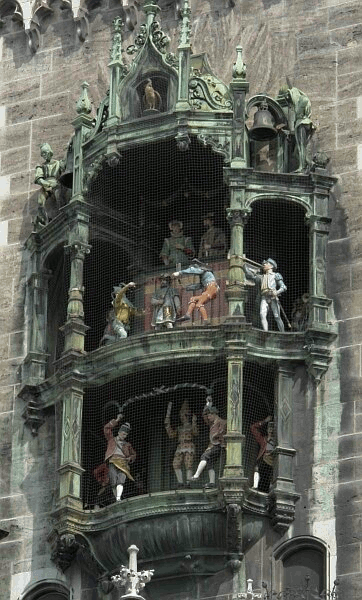 If you click on the image above, you will see a detailed view of the carvings and statues on the front of the Ratskellar.
It's a very wide image when viewed at full resolution, so be sure to scroll all the way across the front of the
building.
If you click on the image above, you will see a detailed view of the carvings and statues on the front of the Ratskellar.
It's a very wide image when viewed at full resolution, so be sure to scroll all the way across the front of the
building.
During the actual show the top ensemble goes around twice, after which the bottom ensemble goes around twice, and finally the
cuckoo at the top goes off (but if it moves, my old eyes couldn't see it).
I have to say that my first impressions of Germany were overwhelmingly positive. Even before we arrived in Munich, we saw wind farms
on the trip from the airport, and we continued to see them as we traveled around the country. While our business leaders are busy
whining about how it can't be done, the Germans are busy doing it. And starting here in Marienplatz, I was heartened to see
that every bicycle rack was full to overflowing: many Germans make it a priority to not use a car when a bike will do.
On my list of musical destinations was the
Residenz, not so much for the museum,
but for the Nibelungensale: five halls
featuring paintings of scenes from the Nibelungenlied. In preparation for this attraction, my "airport book" on this trip
was an English translation of the epic that I had read many years before. What better way to immerse yourself in
Germany than to enter its mythology through these paintings from the medieval tale. And, icing on the cake in a continent that
gives very little away, it was free. Only problem was, it was also closed for renovation!
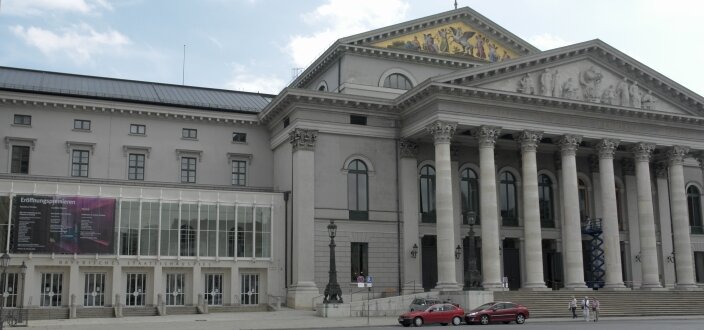 Hardly able to believe my ill timing, I was at least consoled when I found that next door is the
Bavarian State Opera House,
where the premier performances of Tristan und Isolde, Die Meistersinger, Das Rheingold and Die Walkure all were held.
Of course, as with so many buildings in Germany, it was destroyed during World War II and has since been rebuilt.
Hardly able to believe my ill timing, I was at least consoled when I found that next door is the
Bavarian State Opera House,
where the premier performances of Tristan und Isolde, Die Meistersinger, Das Rheingold and Die Walkure all were held.
Of course, as with so many buildings in Germany, it was destroyed during World War II and has since been rebuilt.

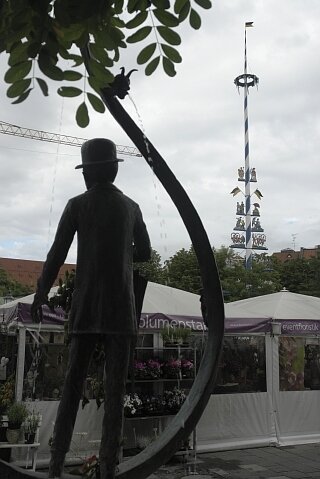 One of our first lessons in Europe is to always eat the hotel breakfast. Mary and I had thought we would do a few things
at the train station (visit the ATM, validate our Eurorail pass, check schedules, get a subway pass) and then breeze out to
Munich's Viktualienmarkt for breakfast. It was almost noon before we got something to eat! When language is a barrier, it doesn't stop
you from doing things, but they definitely take longer.
One of our first lessons in Europe is to always eat the hotel breakfast. Mary and I had thought we would do a few things
at the train station (visit the ATM, validate our Eurorail pass, check schedules, get a subway pass) and then breeze out to
Munich's Viktualienmarkt for breakfast. It was almost noon before we got something to eat! When language is a barrier, it doesn't stop
you from doing things, but they definitely take longer.
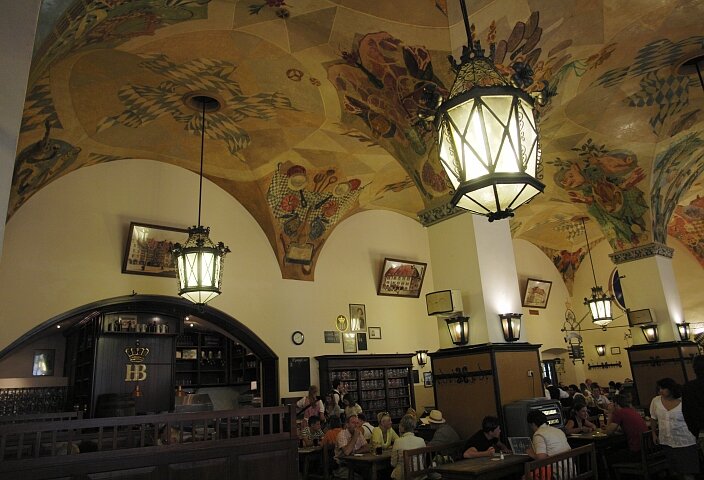 Later in the day we met Carol and Rick and set out for the Hofbräuhaus (for those of you in Cincinnati, the Original Hofbräuhaus).
Or mad house, if you prefer: at 19:00 on a Saturday evening, it is packed with revelers and tourists. With the rain, the
outdoor garden was closed, and we must have hiked the whole place twice looking for a table with 4 empty chairs. Just as we were
about to give up, I noticed a table on the edge of the garden with two young men and 3 empty chairs. They were happy to have us
join them, and with a hastily negotiated fourth chair from another table, we began a delightful evening.
Later in the day we met Carol and Rick and set out for the Hofbräuhaus (for those of you in Cincinnati, the Original Hofbräuhaus).
Or mad house, if you prefer: at 19:00 on a Saturday evening, it is packed with revelers and tourists. With the rain, the
outdoor garden was closed, and we must have hiked the whole place twice looking for a table with 4 empty chairs. Just as we were
about to give up, I noticed a table on the edge of the garden with two young men and 3 empty chairs. They were happy to have us
join them, and with a hastily negotiated fourth chair from another table, we began a delightful evening.
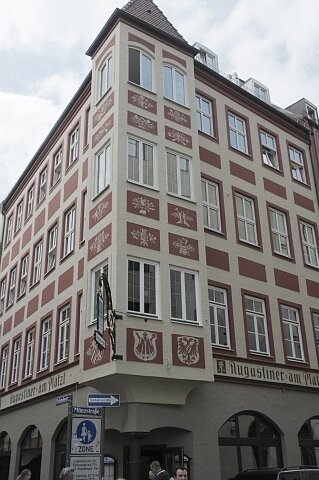
Prosit, prosit, Ein Prosit der Gemütlichkeit!!!
Gemütlichkeit is usually translated as "coziness", but it is a very special coziness: the social conviviality of good friends
in warm surroundings. German can be difficult for the American, but you keep finding these words that, when you come to understand
them, are perfect for the occasion. Each time we would begin, a table of young men across the garden, there for a bachelor
party, would immediately join us and soon the whole garden seemed to be in tune.
It turns out there are Augustiners all over the place in Germany. We had actually eaten at this one for lunch on our first day in Munich.
We found another one about half-way between our hotel and this one, where we had dinner one evening. Both were quite good. Tip: If
you have lunch in Germany and find yourself desirous of a beer but don't want to drink much, try a Radler: a mixture of lager and
lemonade (actually Zitronenlimonade, a lemon-lime soda): very tasty!
Our Castle Tour
For the most part, we planned our trip ourselves, and although there were logistical challenges that we had to overcome as
we went, we had a much better trip for having done so. But reading Rick Steves (who was mostly an invaluable guide), we became
convinced that we would not be able to do better than a "Castle Tour". The thought of engineering our own transportation to
Neuschwanstein and getting there at the time printed on our ticket was too much for our second day in Germany (for those of
you keeping track, this adventure occurred the day before our museum/Hofbräuhaus day). So Mary and I and Carol and Rick bought
tour tickets in advance for a whirlwind tour that got us to Castle Linderhoff, where King Ludwig the second grew up, to
Oberammergau, for a blinding 30 minutes of shopping, and to Neuschwanstein.
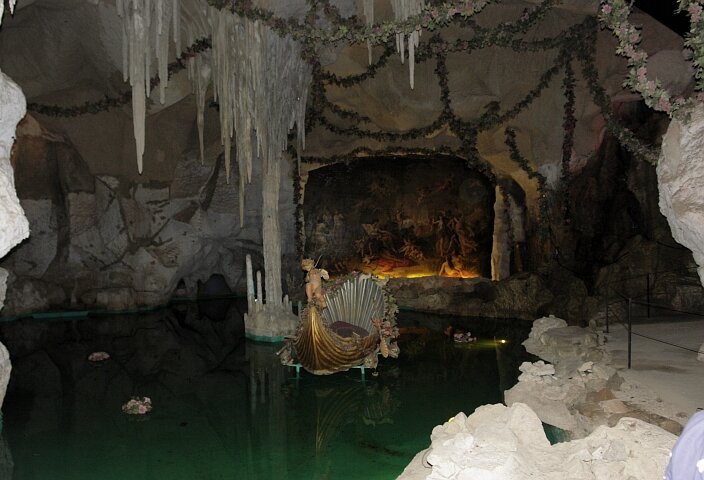 Ludwig really loved Richard Wagner's work. He built the Venus Grotto in the caves in the hill overlooking Linderhoff both
as a tribute to Wagner's Tannhauser and as a place to get away from it all, I suppose. Until we were in line to see the castle,
and I saw the words "Venus Grotto" printed on my ticket, I had no idea it existed. Our tour guide, "Fred", was a pretty strict disciplinarian,
but I summoned the courage to ask if I could see the grotto instead of touring the castle. One eyebrow goes up and he asks: "Can
you do it in 45 minutes?" As I answered, I climbed out of line to leave a slightly worried Mary behind as I trekked up the hill.
Ludwig really loved Richard Wagner's work. He built the Venus Grotto in the caves in the hill overlooking Linderhoff both
as a tribute to Wagner's Tannhauser and as a place to get away from it all, I suppose. Until we were in line to see the castle,
and I saw the words "Venus Grotto" printed on my ticket, I had no idea it existed. Our tour guide, "Fred", was a pretty strict disciplinarian,
but I summoned the courage to ask if I could see the grotto instead of touring the castle. One eyebrow goes up and he asks: "Can
you do it in 45 minutes?" As I answered, I climbed out of line to leave a slightly worried Mary behind as I trekked up the hill.
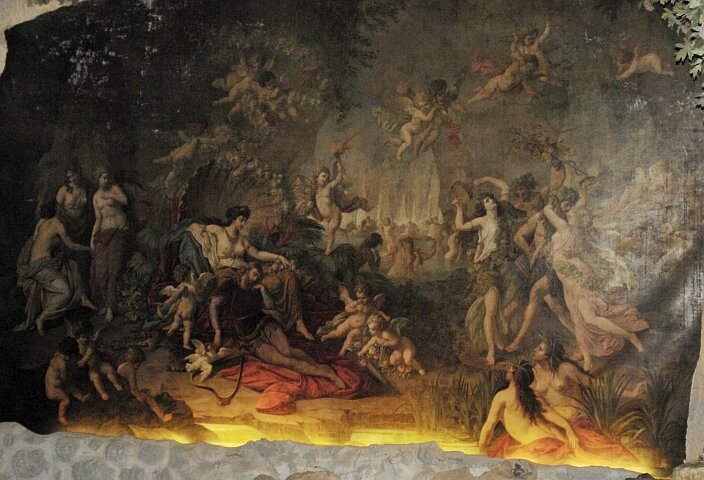 It was a long walk but it was worth it. Perhaps you have to love Tannhauser, but I do. Perhaps you have to be a little
odd, and perhaps I am. But I thought it was very cool, definitely not the sort of thing just anyone gets to see.
The guide gave the tour in both German and English, the overture from the opera was playing, and for a little while I understood
Ludwig. The centerpiece of the grotto is of course the painting, showing Tannhauser reclining at the feet of Venus (Joe, this one's for you!).
It was a long walk but it was worth it. Perhaps you have to love Tannhauser, but I do. Perhaps you have to be a little
odd, and perhaps I am. But I thought it was very cool, definitely not the sort of thing just anyone gets to see.
The guide gave the tour in both German and English, the overture from the opera was playing, and for a little while I understood
Ludwig. The centerpiece of the grotto is of course the painting, showing Tannhauser reclining at the feet of Venus (Joe, this one's for you!).
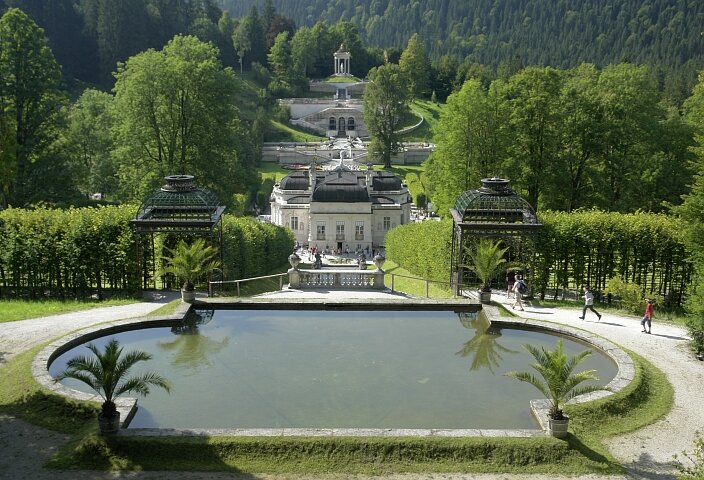 And the bonus is you get this great view of Linderhoff from above! Without having seen the grotto, I would never have guessed this
view was to be found.
And the bonus is you get this great view of Linderhoff from above! Without having seen the grotto, I would never have guessed this
view was to be found.
And I made it back to the bus before Fred.
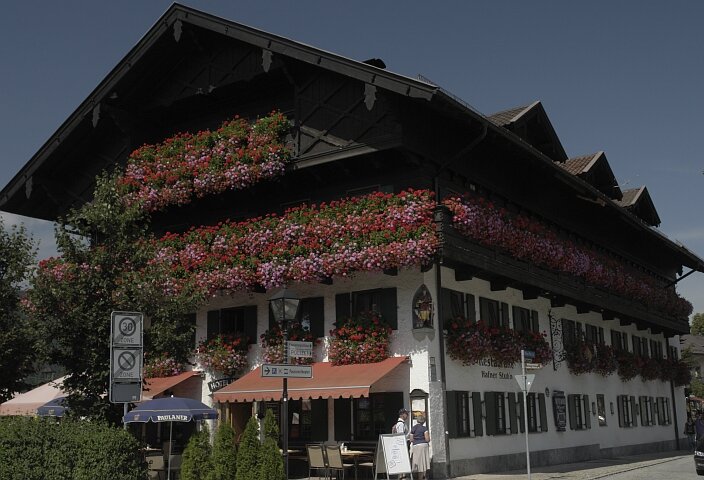 The down side was evident before the bus left the castle: blisters. So unfortunately our whopping 30 minutes in Oberammergau was
largely spent in search of something approximating a Dr. Scholl's. But we had enough time to appreciate the local buildings,
decorated with the characteristic Bavarian window boxes full of geraniums:
The down side was evident before the bus left the castle: blisters. So unfortunately our whopping 30 minutes in Oberammergau was
largely spent in search of something approximating a Dr. Scholl's. But we had enough time to appreciate the local buildings,
decorated with the characteristic Bavarian window boxes full of geraniums:
For the Neuschwanstein tour,
Fred certainly had his timing down. He got us to Müller's Hotel for lunch and gave us strict instructions on how to do things:
"Find a seat, order, then go downstairs to wash your hands; when you come back up your food will be arriving, then eat
quickly because it will take you about 40 minutes to climb the hill; and be at the gate at 15:15!" It all went as planned.
Except you have to be careful walking up the hill because the horse-drawn carriage drivers seem perfectly happy to run you off the road...
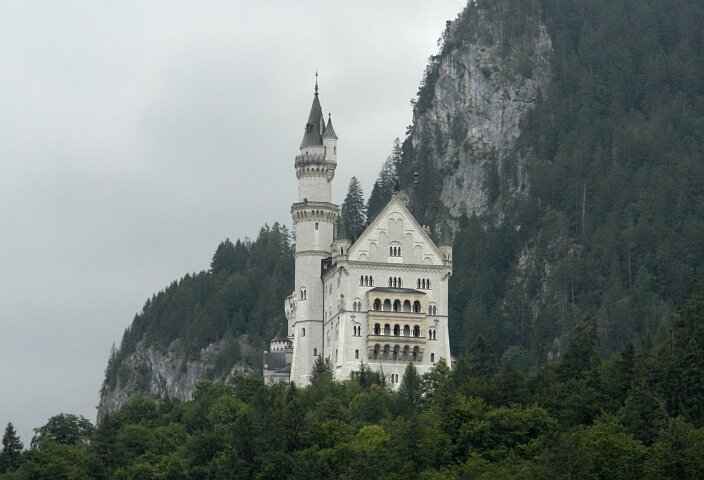 The only problem with the tour is, they rush you through so quickly that you really don't have enough time to absorb what
you are seeing. Much of the castle was never finished, but what was completed is spectacular; if, as Ludwig, you loved
Wagner. For every wall is painted with murals from the German epics which Wagner used as the bases of his great works.
I would have needed at least twice the 45 minutes you have for the tour to take all the pictures I wanted, but of course
you can't take photographs. Otherwise, how could they push tens of thousands of visitors through each day?
The only problem with the tour is, they rush you through so quickly that you really don't have enough time to absorb what
you are seeing. Much of the castle was never finished, but what was completed is spectacular; if, as Ludwig, you loved
Wagner. For every wall is painted with murals from the German epics which Wagner used as the bases of his great works.
I would have needed at least twice the 45 minutes you have for the tour to take all the pictures I wanted, but of course
you can't take photographs. Otherwise, how could they push tens of thousands of visitors through each day?
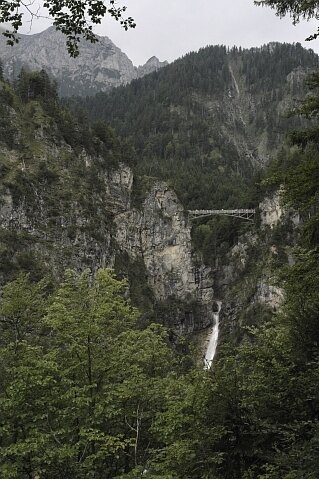 Mary tells me that Linderhoff was the same: very rushed, with no time to appreciate what you're seeing.
Mary tells me that Linderhoff was the same: very rushed, with no time to appreciate what you're seeing.
So my recommendation is this: forget the tour. Stay in Oberammergau for a night or two, hide when the tour buses come, and drive or take a bus to the castles. But when you get to Linderhoff, see the grotto instead of the castle, and spend some time wandering around the grounds. When you get to Neuschwanstein, instead of trooping through the castle with 99 other people, hike instead to this vantage point:
We stopped by the Information Center in the train station and arranged for a room outside the city in Igls. And here we learned our
next valuable lesson: always have your ground transportation figured out before you leave the station. Our bus stop was a couple of blocks
away, but when we got there we discovered that you have to buy your ticket before you get on, and the closest place was: you guessed
it, the train station.
Here is a slide-by-slide pan over the entire view from atop the Patscherkofel:
Ensemble Ardito presented a concert of baroque chamber music by Fasch, Pla, de Boismortier and Handel. The instruments were
baroque oboes and bassoon with harpsichord and chitarrone continuo. The chitarrone is a long-necked lute, perhaps 8 or 9 feet
in length; this one had 8 regular strings and what looked like 4 sympathetic bass strings, with 3 rosettes. You can just see it
at the bottom of this photograph to right of center; it was a beautiful instrument with a lovely sound.
And the performance was amazing. Pla must have been a sadist: I would not have thought you could perform that allegretto on
a baroque oboe!
The next morning we convinced Frau Maria that we had indeed only spent one night with her, then took the bus back to the train station.
But when we came to our stop, we nearly started a riot. I walked to the door and hunted for the button you push to make the doors open; but
it wasn't where it was on the buses in Munich! Finally I found a button and reached for it, when I heard an excited chorus
of "Nein!"s behind me. As it turned out I was reaching for the emergency stop button. But with some help from the locals, I had
the correct button and Mary and I left them behind, a little shaken but not permanently damaged.
We left our bags in a locker and spent the morning walking around Innsbruck. After circling once with the tram we finally figured out that to find
Dom Platz you had to get off a couple of blocks away. We finally found the Golden Roof, saw the museum (which had a very nice video
whose sound played on your personal audio guide) and visited Jakobskirche. Then we got some lunch, and on the way back to the train station saw
St. Anne's Column and the Triumphal Arch.
We visited many churches while touring Europe, but I will show you very few pictures here. This web site is hosted by my
state-supported university; accordingly, I include very little religious art of any kind, in respect of the separation of church and state
which lies at the foundation of our country. But I do not hesitate to include photos of some magnificent musical instruments which only
are to be found in churches: pipe organs.
This is the magnificent organ in the Jakobskirche. I would have liked to have heard it played, but as so often happened, we were in the
right place but not at the right time. For it was time for us to move on to...
(You can click on the image for a panorama of the city from the fortress.)
But Mirabell has much more to offer than simply being a location from Hopscotch, and we enjoyed walking the gardens and see the playground
modeled after The Magic Flute, replete with pyramidal climbing towers.
Mozart's Magic Flute "presents life to us as a wondrous song... It preaches optimism and faith", in the words of Hermann Hesse (from Steppenwolf).
But beyond its scenes of wonder and mystery, it holds a special historical place as the first German Opera; not only because it was written
in German, but because it dealt with ideas in addition to emotions. As the three boys say in Act II, "Part the clouds of superstition,
and wisdom the victor be." Heavy stuff for 1791!
Yet I must fault the Salzburg Festival on several counts. The Grosses Festspielhaus is a beautiful venue, but suffers from a serious lack
of leg room and water fountains. And the organizers priced the tickets too high: there was no evidence of students in the audience. There
should be a sizable population of students at any opera performance, most of all at a Magic Flute! There were no free playbills, so unless you had
the euros and the room in your luggage, you had no information about the production and cast. And then there was the curtain: a crude drawing
of some sort of bisexual creature with large breasts and male genitals, holding a flute in one hand and a snake in the other. Completely
inappropriate for Mozart. But for all that, it was the Magic Flute of a lifetime, and a marvelous way to visit Mozart in the city of his birth.
Somehow I managed to come down enough to sleep, although there were church bells ringing all night: 3 within hearing, all different tones and
some overlapping. I think this painting in the hall of our pension was meant to caution guests to be quiet, but...
Rothenburg is a medieval walled city that has managed to capitalize on its history and still be a lot of fun. We explored a little and
then had a spectacular dinner at Glocke's with a bottle of their own Frühburgunder wine (all the good German reds stay in Germany) and the
best sauerbraten I've ever tasted (and mine is pretty good!). We made it to the Markt Square just in time for one of the "must-see"s of
Rothenburg: The Night Watchman's Tour.
We had been told by several friends that we couldn't miss this act. And it was a hoot: a blend of Monty Python and Henny Youngman (he even
looked a little like Eric Idle), the Night Watchman (Hans Georg Baumgartner) collects his audience each night at 20:00 on the square and
leads them on a walk around the old city, telling stories, cracking jokes and dispensing philosophy. Absolutely worth the price of admission!
(Since arriving home we have had endless joy listening to it; hearing it "cuckoo" on the half hour and the hour lends a delightful
bit of lunacy to your home!)
Our next stop was the Medieval Crime and Punishment Museum. This came highly recommended, and if you are into museums and medieval history
you would enjoy it. It was really very well done, in contrast to other similarly-themed museums we encountered later in Italy. But I don't
cope well with man's inhumanity to man, and for me it was a real medieval downer. I did have a favorite, however: the "Flute of Shame":
During our trip we found that with a little curiosity and open-mindedness we could cope with most of the the foreign aspects of Europe,
but there was one thing that I never
quite got the hang of: restaurant timing. In every restaurant in Germany and Austria that we ate at, the service was spectacular on arrival;
as soon as you sat down, you had menus and a waiter asking for your order. Drinks came almost immediately thereafter, and your food arrived
as soon as it came up. But after that, it was as if they expected you to stay the night; getting your check took some serious effort. I suspect that
there is some secret hand signal that they never tell tourists about...
After dinner we walked back up to the square and met a Canadian couple traveling with Rick Steves' book. One of the advantages of
carrying Rick along with you is that other tourists doing the same immediately know they have someone to talk to.
They don't get many English-speaking tourists in Eisenach, and Rick Steves doesn't say a word about it in his book, so we were pretty much
on our own. A serious challenge... So I got in line for a different person, and got enough from them to know where to find the Tourist
Bureau. Now to find the right bus...
Johann Sebastian Bach's childhood home is now a very nice museum,
one dedicated to educating as well as displaying artifacts. Entry
included a short lecture (in German, of course!) and concert featuring five instruments restored from Bach's time: two organs (one hand-pumped),
a clavichord, a spinet and a two-manual harpsichord. The museum also featured a digital reconstruction of Bach's facial features, a re-creation
of his study, and an ultramodern listening room, where visitors sat in spherical "chairs" suspended from the ceiling and could listen to a
wide variety of Bach's music.
After a long day we shopped for wine and cheese and bread and dessert, and had a quiet birthday dinner in our hotel room.
After signing to the bartender in the hotel that I needed to borrow his corkscrew!
The Wartburg was the scene of the legendary Minnesinger Contests in the 13th century, which inspired Wagner's Tannhauser. The hike
up to the fortress was almost as long as the one to Neuschwanstein, but the tour was far better; more informative and more leisurely. They must get
some English-speaking tourists here because they do one English tour a day. It was our guide's first public English tour, and she
did a wonderful job. We saw many of the rooms in the main building, including one which told the story of St. Elisabeth in mosaic tile on the ceiling.
This tapestry depicts one famous singing contest that is supposed to have occurred in the room it now hangs in:
But Leipzig was a wonderful town to visit, at least in the historical central portion we saw. It is a city in the process of blooming,
like a mini-Manhattan re-inventing itself from the ashes of its recent past. I find it very satisfying that the Europeans
preserve their historical buildings instead of tearing them down and replacing them. They are even building a subway system under the 800-year old city!
After getting settled, we walked to Auerbach's Kellar for dinner with Faust. Goethe was a frequent visitor in his day, except that he
spent his time in what is now the "historical" side of the restaurant, where the prices these days are much higher than on the
"tourist" side. The walls on our side were painted with scenes from Faust; the large seating area was broken up by a series of arches;
Faust and Mephistopheles straddled a huge wine barrel in the bar area...
In a charming example of the universality of parenting behavior, we watched a Greek couple as they helped their youngest daughter with her dinner: Mom
pushing vegetables at her while nibbling on the child's french fries, Dad handing his daughter the fries...
On the way back to our room and laundry, we encountered a student who had just arrived in town and couldn't locate her destination.
In a classic example of the blind leading the blind, we gave her our city map and offered our best guess as to where she should go.
Our hotel desk clerk was happy to give us another map.
That night I came up with one more item to bring to Europe next time: a small battery powered fan!
This is the 1889 63-voice Sauer organ we heard during the service, and it was very impressive:
The church had a long history of "peace prayer" services which the East German government quietly tolerated as long as they were small
and quiet. But in 1989 a growing movement pushing for emigration caught the attention of the Stasi. It began with blockades and became
beatings and arrests. When they could not put a dent in the non-violent movement, they tried stacking the deck, filling the church with
their own people. After the service those inside were welcomed by thousands outside waiting with candles in their hands; the police and
the spies and the troops folded. As one member of the GDR Central Committee said later, "We were prepared for anything. But not for candles
and prayers." It takes a great deal of courage for a people to fight injustice with non-violence.
After mass we ate at Alte Nikolaischule; where once Wagner sweated through his Latin, there is now a hotel and very nice restaurant. And
as a former student of particle physics, I had to have a quark fritter for dessert! Of course in German, the word quark is not commonly
associated with elementary particles inside the nuclei of atoms, but rather with... cottage cheese. It was garnished with apple and star
fruit slices, and a fruit that was wholly new to us: physalis. Our waitress was kind enough to write the name down for us so that we could
remember. It was a lovely end to two marvelous days in a city that both surprised and enchanted us. And tomorrow we were heading for what
was to me the highlight of the entire trip:
With rain falling on and off all afternoon (except for the afternoon at Neuschwanstein, the only rain we had had since Munich), we got
a late lunch and headed off for Villa Wahnfried, Richard Wagner's home in Bayreuth and now home of the Richard Wagner Museum.
Pity the museum was such a disappointment. It started out very impressively; after paying your entry fee, you find yourself in the Hall
with the piano on which Wagner composed several of his operas, the ethereal music of Parsifal playing from the sound system. Wow!
But as you walk through the museum, you discover there is no English to be found. I recognized perhaps one fourth to one half of the
items on display, Mary almost none, and for both of us the impression was of a museum where education was secondary to reverence. Even if
you had the foresight, as I did not, to buy the English guide as you entered (increasing the cost of the museum by a sizable fraction), you would find,
as I later did, that only a part of the displays are described. So regarding what I said earlier about not needing to learn the language:
there are definitely places where you will get much more out of your trip with a solid language course under your belt.
We went through the museum rather quickly, seeing everything and understanding little of what we saw, and then headed out back
to find the grave site. Richard and Cosima Wagner are buried together in the garden behind the museum, amid mountains of ivy and with
several decaying bouquets representing various Wagner Societies from the Festival which had ended only the week before. I am perhaps
getting more sentimental in my old age, but I did feel rather like I was visiting a dear relative. Wagner just has that effect
on some of us, I guess. So did Bach.
The tour was fantastic! Even Mary, never the Wagnerite, was impressed. Our guide, who spoke no English, was the nicest fellow you
would ever want to take a tour from. He was personable, he answered questions, he gave us plenty of time to look around; it was
easily the best tour we had taken, even if we did not understand a word of what he said. When I asked if I could take pictures, he
solemnly shook his head no, and then, with a twinkle in his eyes, turned his head and hid his face behind his hand.
I took a number of very treasured photographs,
without flash, of course, and while I can't share them with you here, I can tell you that they turned out better than I had hoped.
It was breathtaking to walk into the theater that I had heard so much about, had always wanted to visit, had searched for
recordings from... For nothing sounds like a recording from Bayreuth; the acoustics are wonderful. It almost brought tears to my eyes,
just to be in that place and think about all the musical history that has been made there. We got to sit in the seats (which have
a little padding on the seat, none on the back, but more leg room than in Salzburg). We got to walk through the orchestra pit,
invisible from the audience, and see the unique design and layout of the orchestral sections, with the baffles over the horn section.
We saw the chair that had accommodated
the great conductors, from Richard Strauss to Arturo Toscanini to Wilhelm Furtwängler to Herbert von Karajan to Karl Böhm to Pierre Boulez...
the list goes on and on. Then we walked onto the stage, which still had some Parsifal on it from the week before. And for the finale, we
were able to walk out in front of the curtain, and view the theater from the stage. It was hard not to break into song, although
we managed.
I also have to mention that the other 8 tourists with us were very nice and considerate. And this time I highly recommend buying
the English guide. The Festspielhaus tour was everything I could have wished (except perhaps if it had been given in English).
After a couple postcard errands, a bit of wandering, a lecture from a bus driver about how to get on the bus (!) and then getting on the
wrong bus, we managed to find a great place to eat (try the Göttingen sausage at Oskar's). We had started to get a little "wursted-out"
in Germany, and had sort of enjoyed the fact that many menus in Bayreuth seem to feature Italian food, but it was good to get
some German cuisine on our last night there. The rest of the trip would be spoken in Italian!
On the way back to our hotel, we enjoyed this bit of whimsy across from the train station:
We had observed the night before that the street outside our room was a very noisy place; lots of cars and noisy street signs. But tonight
there was a special treat in store for us: a birthday party in the restaurant across from our window. It was a hell of a party; very loud
Armenian or Turkish music, very rhythmic, a lot of table-pounding and clapping and laughing and singing...
We had thoroughly enjoyed the first half of our trip. Aside from two mystifying facets of German life: so many of them smoke, and they don't
give you tap water in restaurants; we felt almost at home there. Even the faces were familiar; but then again, Cincinnati has a large German
heritage. And so we had high hopes for Italy. But in retrospect, Italy remains a mystery to me, and a paradox.
We had a full day of travel to a somewhat problematic end. There was no problem with our connections in Nurnburg or Munich, but 10 hours on a train
with two little pieces of cheese and two granola bars apiece is a little rough. When we arrived in Padua, we found the Italians to be a pushy, unpleasant
bunch, at least in groups. Walking to our bed and breakfast,
we found out that we had to traverse a pretty rough-looking neighborhood to get there.
But when we arrived, our host Lorenzo was a prince, and it was easily the most elegant digs we would have the entire trip. Of course we
had to walk back through the neighborhood to the Pizzeria that Lorenzo recommended, and it turned out to be primarily take-out: hot and with
only 4 stools. But we had nowhere
else to go, and the cook told us "Sit! It's a restaurant!". And so we ordered pizza from a huge selection (in Italian only) and thought we were
ordering something very different from what we got: eggplant, which neither of us like. But we survived the evening, and looked forward in the morning to...
We took the train in from Padua and from the beginning it seemed like a cliche: every major train station in Italy was playing the same
4 bars from Madame Butterfly over and over and over... Riding the vaporetto along the Grand Canal was expensive (28 euros for a day pass for two!)
but a nice way to see a lot of the city at once. We got off at San Marco Square and wandered through the throngs before getting some lunch.
This turned out to be a good move, because after lunch the lines to see the cathedral were much shorter.
But as with all of the churches we saw in Italy (and in Italy you see a lot of churches!), I can't show you any pictures because no photography
is permitted. Not even without a flash and tripod. Now I'm sorry, but without flash, photography is a completely passive act, which
cannot harm the art. The only reason for prohibiting photography is to maximize your profits at the gift shop. And of course there are
still lots of inconsiderate people taking flash pictures, both with digitals and with cell phones.
So I can only tell you that San Marco was breathtaking: the ceiling mosaics are so small and intricate you could easily mistake them
for gold foil. There were Escher-esque designs in all the floors and gorgeous marble everywhere.
Afterwards we wandered around again for a bit, had a gelato, rode the vaporetto some more, and decided to go back to Padua. At the time, neither
of us liked Venice as much as we had expected; but at least there were no mosquitoes! And the train car we were in on the way back to Padua was
nicely air conditioned. Of course, there were no announcements before every stop like there were in Germany and Austria, so we had to watch
pretty closely to make sure we didn't spend the night wandering around Italy.
Our first impression of Padua had not been all that great, but our second was very nice. We took the tram out to the Basilica of San Antonio,
which was very nice. The only downer was the tour group whose guide had the gall to invade the church and explain the reliquary to his flock
while services were going on. We had picked up a small booklet and asked the friar how much it cost, and his eloquent response was a
dismissive "donation, donation." I felt sorry for him as he shook his head over the tour group. This is where my hatred of tour groups started.
Guided tours are a plague on the tourist landscape. The guides usher their little sheep around, most of the time not caring whose view they are
ruining, whose path they are blocking, or as with this cretin, whose services they are desecrating. So I exhort you: plan your own
tours and go out there and explore the things you want to see! Read up on your destinations ahead of time, and bring your tour
book so you can learn about and appreciate what you see, quietly and individually. Don't be afraid to plan your own itinerary: that's part of the fun!
OK, I'm off my soap box now. The organ at the Basilica seemed to be the oldest one we had seen yet; the pipes seemed to be iron or zinc, not
shiny at all, and they had a very different sound. They sort of reminded me of the lone recording I have of the unique iron gamelan salunding in
Tenganan, Bali; softer, sweeter, maybe. We couldn't see it, but the console was in the choir loft, not with the pipes.
We got out a bit early for dinner; in Italy, good luck finding a restaurant open for dinner before 7:00 or 7:30 in the evening. So we sat across
from the Basilica and shared a bottle of wine while we waited for the dinner staff to show up, and reflected on how much more we enjoyed
Padua this afternoon compared to the day before, and how much less we enjoyed Venice than we had expected. And this time we were smart, and called for
a cab back to our room; going that way, you don't even notice the rough part of the neighborhood!
It had been almost two decades since I had driven a car with a manual transmission, but it came back to me reasonable quickly (at least as
soon as I got used to the Punto's clutch, and figured out exactly where third gear was...).
But the problem is not with the car; it is with the Italians. For them, the speed limit is a starting point,
and the lines on the road mere suggestions (at one point, we saw 4 cars abreast on a two-lane road!). And they are even more aggressive on the road than
they are in train stations and at bus stops; they seem genetically wired to tailgate you, stay in your lane as they pass you and cut you off
before they roar off into the distance. And the motorcyclists are even worse: of course one lane has room for a car and a motorcycle side by side!
This is all very difficult for someone with a German disposition and a healthy respect for the rules of the road.
And then there's the problem of navigation. I'm a map fiend; I'll take a paper map any day over MapQuest. I love to explore the interconnections
of roads, figuring out which routes to take to see the most of the countryside. So before we left Cincinnati, I had purchased several good road
maps of Italy, and had worked out which route numbers to take to get just about everywhere we wanted to go.
So it was a difficult adjustment when I discovered that you can be on a road for 30 or 40 kilometers before you have any idea if you are on the
correct route! Route numbers are just not important to Italians. What matters is the order of the towns you go through to get
where you're going. Every major intersection of roads is a traffic circle, and near each road is a list of towns you might find in that direction.
So to plan your trip, you don't count on taking the 408 to the 429 to the 222; you plan on going toward Gaiole in Chianti, then toward Radda in Chianti,
then toward Castellina in Chianti, and finally toward San Donato in Chianti.
They simply don't think like I do; I see the road system as a network of roads, they see it as
a maze. This bit was even harder for me than dealing with the Italian drivers.
In retrospect, I think it was a mistake to try to drive in Italy at all. We had followed Rick Steves' advice to get a car to see the hill towns
of Tuscany. But I would rather have used trains and buses, and stayed in each town a day or two, than do as we did and take a series of day
trips from a central location. During the 8 days we had the car, I noticed my jaw getting more and more sore, and I started to worry about
the prospects of having dental work done in Italy. The day after we dropped the car off in Florence, the pain was gone; I had been
gritting my teeth all that time. Driving in Italy drove me to distraction!
But Montepulciano was a lovely town, and a strenuous introduction to the concept of "hill town"; there is a reason why they are called that.
After climbing and exploring and climbing and exploring, we had a delightful (but very breezy) dinner al fresco as the sun set. And as
we climbed back down to our beds, Richard and Karen and Nancy were in the air over the Atlantic Ocean, on their way to join us.
No such luck. Now we were in a bit of a conundrum. No word, no idea when to expect them, and somebody had to be at the villa to get the keys from the
owner between 5:00 and 7:00 PM. So we loaded all the luggage into our Fiat, and Mary and I took off for Chianti while Rick and Carol
watched the town prepare for the evening's festivities and waited hopefully for our family to show up on the 4:10.
From Montevarchi to Poggibonsi is a wild ride: lots of curves and switchbacks and hills. Nothing like the straight little
line on the map would have you believe! The road was nicely banked, making driving strenuous but fun, through gorgeous scenery, and a lot
more woods than I expected. And everywhere you looked there were olive groves and vineyards. About 4:15 we got a call from Carol:
Richard and company had indeed arrived on the 4:10. The communications blackout was due to problems with the phone card, and the delay
was courtesy the airline, who lost Richard's bag and to date (almost two months later) has still not found it!
It was about this time that I missed the turn to San Donato. After backtracking to find it and not succeeding, we went on to Poggibonsi and
called our hostess Giana for help. We took the Superstrada (one notch below the Autostrada) to San Donato and, following her directions, turned left at the
sign for Monsanto onto the "dirty road".
When we got to the top, we called Carol, pleaded with her to stop for food before they came up the hill (we weren't sure we were ever
going to make it back down), and gave Rick just enough suggestions for attacking the hill to scare them all to death. About 45 minutes later
another car pulled up behind ours with only Rick inside; they didn't think they would make it up with 5 people in the car, so
the rest of them walked!
After finding Giana and getting acclimated, her husband Aldo stopped in with 4 baskets of fresh eggs, pears, apples, and the best tomatoes
we ever tasted, all from his farm. We were in sight of their vineyards, and there were olives on the hoof just outside our windows:
We wandered around quite a lot looking for the town square ("Il Campo"), and after a gelato stop and some more wandering, we found it:
(You can click on the image for a panorama of the square looking in the opposite direction.)
We also found a wine museum, which was most interesting for the huge number of wines you could sample. We finally tasted a Brunello from
Montalcino: very rich, with a bitter finish; liked it quite a lot but it was too expensive to buy a bottle. We walked back to the square
for a nice lunch and then drove off in search of Castello Vicchiomaggio, a winery that has been in continuous operation for over a thousand years!
We also tasted the Grappa: distilled wine,
not unlike brandy, which the Italians like to add to coffee. Now that's a wake-up call!
We bought some wine (surprise!) and returned to our farm house for dinner and mosquitoes and huge flies and moths; you'd have thought
Leonardo could have invented screens.
We ran a little late at the church and ended up looking for a restaurant just about the time when they all close for the afternoon.
But one enterprising young fellow
agreed to feed us, and did a very fine job of it. Even brought us a couple of fans (it had been beastly hot all during our time in Tuscany).
After lunch we finished our hike to the square and saw Minerva's Temple, which fronts another church. Then Mary, Richard and I decided to
take a taxi back to the car so Richard could do some clothes shopping on the way back to Chianti. Riding down those narrow hill-town streets, it is
better not to open your eyes; on more than one occasion I thought we would either hit someone, or not fit through the opening there was.
But our driver did a good job not committing vehicular homicide, and we were off again to shop, buy some groceries, and spend the evening
battling with international dialing. Hint: a lot of 800 numbers will not accept international calls.
Not to be left out of the tourist trap business, the Duomo charged 3.5 euros to get in, and for your money you're not even allowed to
take pictures without flash. So it was time for a little ecclesiastical disobedience. I surreptitiously took several pictures (which I
won't share with you here) of some of the magnificent frescoes. Several could even be appreciated by someone who had no special
knowledge of the lives of the saints: scenes from Hell, God breathing life into Adam, and "taking" Eve from the sleeping Adam's chest.
I guess I was forgiven; my flash drive didn't crash before I got home...
But in the end the heat beat me, and I sat for a bit while the others explored. Richard found a reasonably inexpensive bottle of Brunnello
to cheer me up, and after grocery shopping at the co-op and once again beating sundown up the hill, we enjoyed it after dinner.
It was reminiscent of a very dry sherry.
We walked down to the Uffizi and found a small place to buy pastries while we waited for our entry time. Mary was blessed by a local
pigeon, but we managed to get our tickets and trek to the top floor. I was really looking forward to seeing The Birth of Venus and
Primavera, but when we finally found them we were all pretty disappointed. Not only were there so many people that you couldn't just
sit and take them in, but they seemed drab. Both have protective glass mounted a few inches in front of the paintings, and perhaps
that is to blame, but the pictures you see in books look much more vibrant, the colors much more intense. After about two and a half hours
in any museum I get saturated, and by that time we had only seen a half of the top floor, mostly Gothic stuff that I just don't appreciate.
So at this point, I am still not impressed by Florence.
And lunch didn't help: our snotty waiter crowded us into 2 tables when 3 would have been appropriate (the third went unused). The food
was good enough... On our way to the Accademia to visit David we happened on another of the world's best gelaterrias:
Perche No. And this one to me was even better than in San Gimignano, although there was
some debate about it.
And then there is The David. I had been skeptical, but Mary had seen it when she was in Florence in 1972, and I was game. She had this
one right: as soon as you walk in sight of it, it owns your attention. In my journal I called it an excellent portrayal of anatomy in marble,
but that doesn't even begin to convey what I saw. The veins and muscles in David's arms look as real as my own, yet he has the
advantage of marble over poor flesh and blood. I would love to show you the picture I took, but of course I can't because photography
was once again prohibited. And this time they had a plainclothes attendant playing camera police, a little Mussolini who seemed to
enjoy fussing at every idiot whose flash gave them away.
There were some nice musical instruments in one gallery but the rest of what we saw was more Gothic art. We caught the bus back at the
now-closed Duomo and only by the grace of a very nice lady were we able to find our garage and car again. But on the way we were
treated to some of Florence's advanced technology: a computer screen mounted on the ceiling of the bus, continually rebooting
Embedded Windows XP.
Pisa was a traffic nightmare. Only by accident did we find a sign for the parking lot that Rick Steves recommends. Then we went in some
weird spiral for 6 or 8 turns until we saw more signs and finally found it. At that point it's only a several-block walk to the Campo di
Miracoli and the Baptistry and the Duomo and the famous tower... and stall after stall of the worst junk for sale that you can imagine.
Topped off by wandering men selling knock-offs that land you a thousand euro fine if you buy one, although it seems perfectly
legal to sell them. The acoustics in the Baptistry were nice, and there of course is the novelty of the Leaning Tower:
On the way back, Tuscany made up for all the dry days with a vengeance. We drove through the worst hail storm I have ever seen (and the
Midwest can have some doozies!); at one point there was so much hail on the road that it felt like the "dirty road" up to our farm house!
We had lost Rick and Carol and Nancy going in to Pisa and only after a forgettable lunch had we found them. So when we left, they had to walk back
to the train station where they had parked, and there they learned something that made our Tuscan week insanely complete: there would be a
one day rail strike in Tuscany the next day. That of course was the day we were counting on using the trains to get Richard and Karen and
Nancy back to Rome, and the rest of us to Cinque Terra! How does anything ever get done in Italy?
I think now that driving in Italy had colored my experience somewhat, and as I wrote in my journal that night about the awful day, we had
a wonderful breeze, thunder and lightning and rain (all of which I like); it almost made up for it. But of course it couldn't end there:
the downstairs apartment lost power, Richard's bed broke and we all lost hot water.
On top of the weird water pressure problems we had had the day before, I was really ready to move on.
So I have the distinction of having visited Rome for 15 minutes. Richard, Karen and Nancy stayed in Rome and had a wonderful afternoon
and evening before flying home, and their bags arrived only a day after they did. And we made it to Corniglia, where our hostess found
us in the (then) crowded square by calling our cell phone and seeing who answered. Clever! She led us up... and up... and up... to a
lovely pair of apartments which were our home
while exploring the five towns.
On the way back to dinner we caught a beautiful sunset:
Corniglia is a quiet town, especially on Sundays, except for a sickly-sounding rooster that gets fired up at the crack of dawn and
keeps at it until he's exhausted (sometime well after 9:00). We bought a Cinque Terra card, which gets you train rides and bus rides
in the five towns, and headed off to...
Descending the lift, we found the Via D'Amore (which our card was also good for) and walked towards Manarola. It's a beautiful walk,
something growing everywhere you look. Unfortunately there is a ton of graffiti, even carved on the leaves of the cacti. My polarized
glasses treated me to a sight that most people don't get: where you see only sunlight scattering off the foam, I saw small fish
(probably anchovies and sardines) swimming underneath, catching the sun and sparkling like sapphires in the surf. Very cool!
Trains in and out of Vernazza are almost insanely packed, at least in the late afternoon. Rick and Carol had been to Monteroso, but Mary
and I had skipped it for lack of time, and because of its reputation as a high-end tourist destination.
After a 50 minute ride to the airport, we had to walk the length of the terminal twice trying to find the Delta counter (which was
closed up tight!), a restaurant and the gate where the hotel shuttle would take us to our beds. A nice dinner, and a real change of pace:
no laundry! For tomorrow, we fly home. And I must say, we were ready to be back.
One more thing: if I ever fly long distances again, I will definitely pay the extra for first class. If you are at all tall, the
seats in coach are tantamount to torture; it is unconscionable the way the airlines pack you into those tin cans.
So would I do it again? Absolutely!
This was the trip of a lifetime.
And perhaps I will take Lorenzo's advice, if ever I brave Italy again,
and spend some time in Cittadella.
It looks beautiful in the pictures...
©2008, Kenneth R. Koehler. All Rights Reserved.
This is where the really good view of the castle is, and you can spend time looking at it in leisure, with relatively few
crowds around.
Innsbruck, Austria
Rick and Carol rented a car and drove north, and Mary and I took the train south to Innsbruck. Our Eurorail pass was a Selectpass Saver for two:
Mary and I had 10 days of rail travel in Germany, Austria or Italy. And since it is a first-class pass, you have fewer seating
hassles then if you were buying individual second-class tickets. But there are some things to pay attention to. You should always know
the train number, departure time and platform number before you get to the station. We would always get that information for the next
leg of our trip before we left the station we arrived at. Most stations have a diagram on the platform telling you where the
first-class cars are, so you can wait approximately where you want to get on the train: many of the stops are only a few minutes long,
so you want to be organized. You usually have to push the green button to get the doors to open, and when choosing a seat, make sure
no one has reserved it. Some trains require reservations, but you can usually work that out once you get on the train if that
one gets by you.
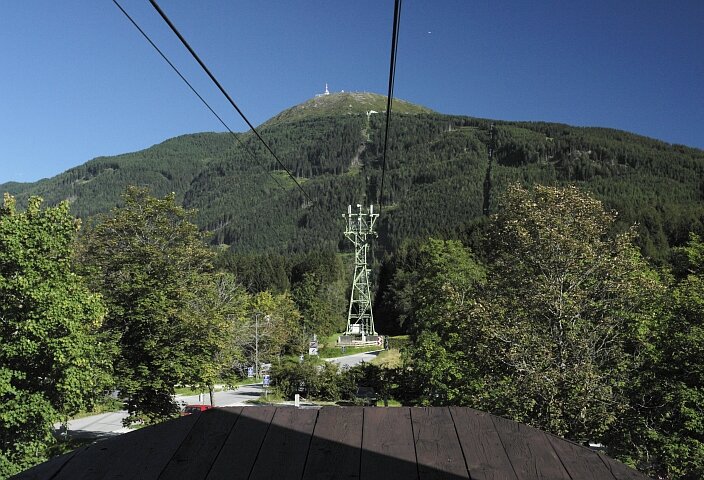 Mary had chosen Igls during her researches because it hosts a lift to the top of a mountain where there is an alpine garden walk.
This is the view of the Patscherkofel from the bottom of the lift.
Mary had chosen Igls during her researches because it hosts a lift to the top of a mountain where there is an alpine garden walk.
This is the view of the Patscherkofel from the bottom of the lift.
Even without snow it is a lovely area, and the views are spectacular. It is no wonder that the Olympic Committee chose it for the
site of the Men's downhill race and the Bobsled run in 1964 and again in 1976. For the young and fit there are hiking trails to the
top, but we elected to take the lift, which stops at the station at the top of the tree line and at the base of the rounded mountaintop.
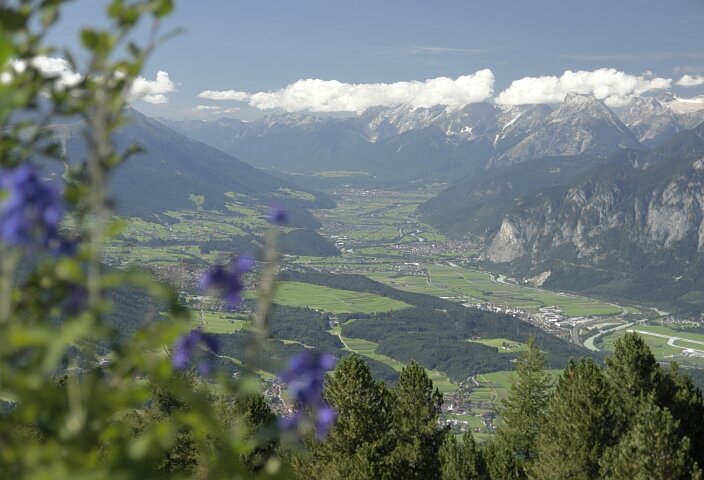 This is the view looking north along the Inn River valley just to the west of the city of Innsbruck. It was a glorious day,
clear and sunny, with happy Tirolean cows wandering in the meadow next to the lift. The Alpine Garden was lovely, an easy walk
which gave us just enough appetite to share my Tirolean potato dish, Mary's cold pork plate, a couple of beers and a delicious apple
strudel. Mary's dish had something that looked like sprouts on it; it took us a little while to figure
out that they were wild horseradish. Neither one of us are great fans of horseradish sauce, and this was our first experience
with them in the wild, but they were very tasty.
This is the view looking north along the Inn River valley just to the west of the city of Innsbruck. It was a glorious day,
clear and sunny, with happy Tirolean cows wandering in the meadow next to the lift. The Alpine Garden was lovely, an easy walk
which gave us just enough appetite to share my Tirolean potato dish, Mary's cold pork plate, a couple of beers and a delicious apple
strudel. Mary's dish had something that looked like sprouts on it; it took us a little while to figure
out that they were wild horseradish. Neither one of us are great fans of horseradish sauce, and this was our first experience
with them in the wild, but they were very tasty.

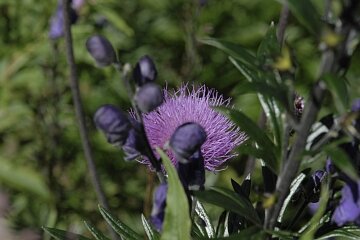 Here is one of my favorites from the alpine garden, but I have no idea what to call it besides lovely. If
any of my readers know its name please let me know.
Here is one of my favorites from the alpine garden, but I have no idea what to call it besides lovely. If
any of my readers know its name please let me know.
Our hostess, Frau Maria, had told us about a concert being held that evening at the parish church, so eventually we dragged ourselves
off the mountain, freshened up, and walked toward the center of town. Passing #6 Bilgeristrasse, we encountered something unique in our
experience: it is a barn filled with manure, and there is a fan which ventilates the building, which blows out just at
eye level as you walk past. But Igls was a very nice town and a much better fit for us than Innsbruck would have been. It had a more
homelike atmosphere about it, and was a refreshing change of pace after the busy-ness of Munich. There were even goats roaming the hill
across the street from our room.
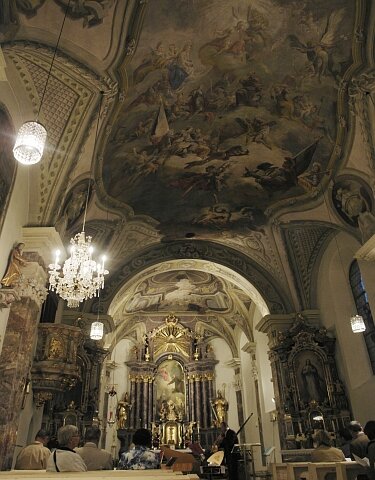 Before the concert, we had a delicious second dessert and coffee across the street from the church. For a small parish church, it was
beautiful inside, and very chaste: all the cherubs had gold leaf covering their privates.
Before the concert, we had a delicious second dessert and coffee across the street from the church. For a small parish church, it was
beautiful inside, and very chaste: all the cherubs had gold leaf covering their privates.
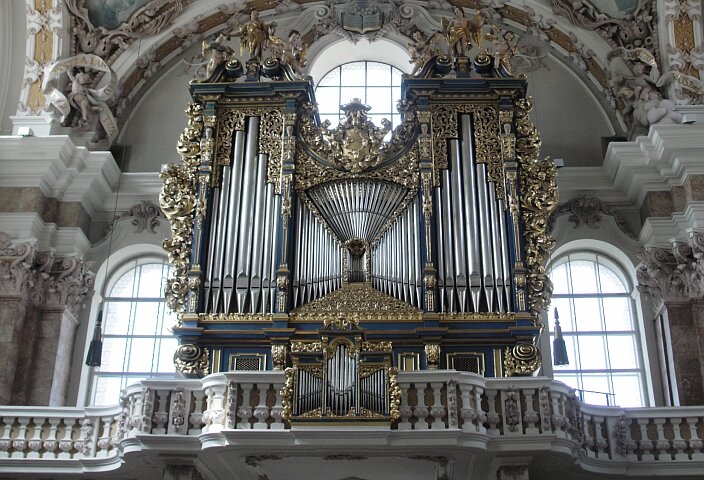 The king of instruments, I have a love affair with organs that goes back a long way. One
of my fondest memories from my undergraduate days is when my music theory professor, Dr. Benedum, gave me informal lessons on the
small pipe organ owned by the Music Department at the University of Dayton. Even on a small instrument, the sound is wonderful,
and a large instrument in a large space can invoke emotions from the sublime to the awestruck.
The king of instruments, I have a love affair with organs that goes back a long way. One
of my fondest memories from my undergraduate days is when my music theory professor, Dr. Benedum, gave me informal lessons on the
small pipe organ owned by the Music Department at the University of Dayton. Even on a small instrument, the sound is wonderful,
and a large instrument in a large space can invoke emotions from the sublime to the awestruck.
Salzburg
Where we left the train station and promptly got on the right bus... going in the wrong direction. So while we did the bus route,
we talked with a nice young lawyer originally from Sandusky, Ohio. She was traveling the high life with her husband, who worked for
an airline, with lots of free plane tickets and free 5-star hotel rooms. We had a nice chat about travels in Europe, but as we got nearer
to our stop, I immersed myself in my map of the bus routes (as was her husband), and before I knew it they were gone. So to them: I hope your travels
were as interesting as ours!
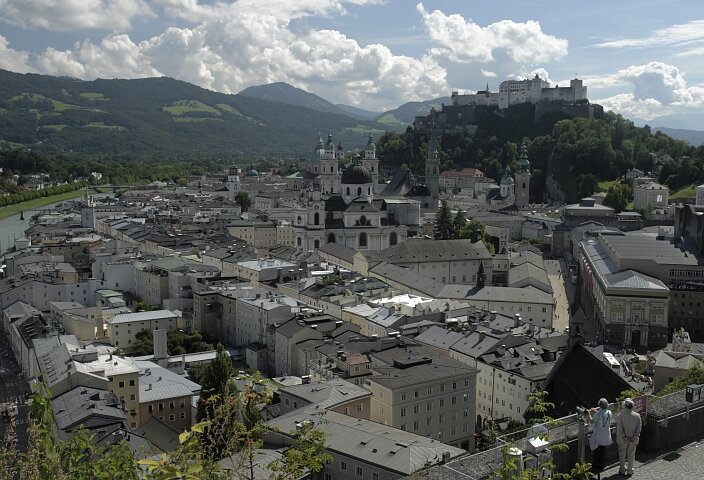 Our room was in the old town, at Christkoenig Pension. Perhaps the most spartan of
our European digs, it was nothing if not reasonable and convenient, at least for during the Festival. Our day began riding the
funicular to Hohensalzburg Fortress. A funicular is basically a pair of elevator cars on a single cable, riding up and down a steep rail;
very simple and very quick! The fortress is seen on the top of the hill right of center in this picture:
Our room was in the old town, at Christkoenig Pension. Perhaps the most spartan of
our European digs, it was nothing if not reasonable and convenient, at least for during the Festival. Our day began riding the
funicular to Hohensalzburg Fortress. A funicular is basically a pair of elevator cars on a single cable, riding up and down a steep rail;
very simple and very quick! The fortress is seen on the top of the hill right of center in this picture:
We enjoyed the self-guided tour and left just as the tour crowds were arriving. After walking to the ticket office to pick up my
ticket to The Magic Flute that evening, we found the Monchsburg elevator and took it to the top. In addition to the beautiful view
seen here, we were looking for something else: the location used in shooting the scene from Hopscotch where Walter Matthau and Glenda Jackson
meet at the restaurant. There is a restaurant here, and although it didn't look right, the movie was filmed in 1980... As it turns out, I
suspect we missed the actual location by about a hundred yards. There was another restaurant, the Stadtalm, which we didn't
realize was there. Sometimes when you're exploring you can miss the trees for the forest...
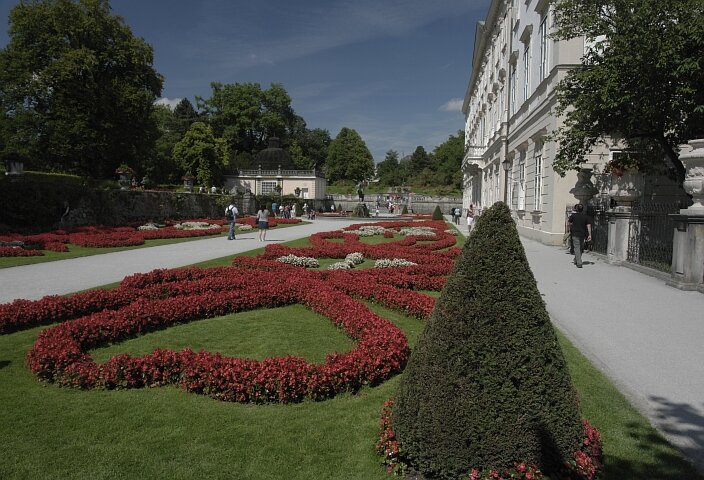 But we still had to meet Yazkov at the fountain, and this one I knew I could find. The fountain is in Mirabell Gardens, which are
gorgeous even when you're not scouting old movie locations. One of my favorite parts is shown here:
But we still had to meet Yazkov at the fountain, and this one I knew I could find. The fountain is in Mirabell Gardens, which are
gorgeous even when you're not scouting old movie locations. One of my favorite parts is shown here:
In the distance you can see the Centaur from which Kendig and Yazkov were photographed; except there is no way the
shot from the movie could have been taken in real life. But of course, this is why directors and film editors win prizes: they can
cut and paste reality into something else which is sometimes even more interesting.
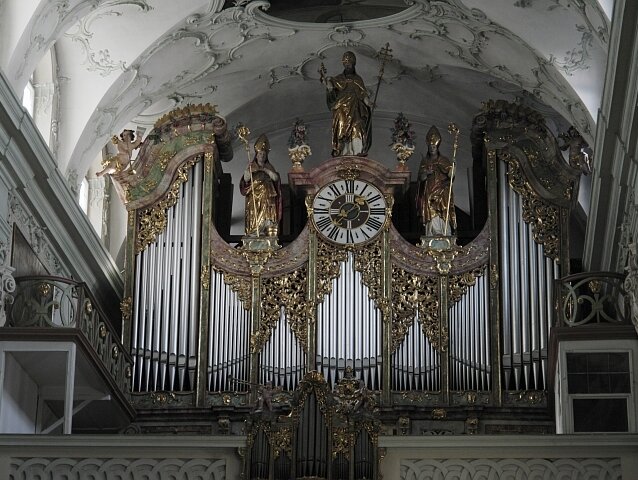 We walked back across the river to the old town, and after a very nice lunch saw St. Peter's, the catacombs and the cemetery. Here is the
organ at St. Peters, clearly another work of art:
We walked back across the river to the old town, and after a very nice lunch saw St. Peter's, the catacombs and the cemetery. Here is the
organ at St. Peters, clearly another work of art:
We also visited the cathedral, which had 5 (!) organs (I'll spare you the pictures) and after dessert we picked up a bottle of wine for poor
Mary, who had to sit alone in our room while I delighted to The Magic Flute!
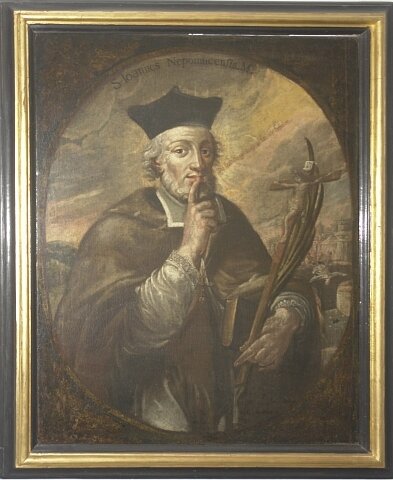 But beyond the philosophy, The Magic Flute must always be a magical performance, and this Flute was no exception. The Vienna Philharmonic,
surely among the most sublime of Mozart interpreters, played every note lovingly under Maestro Muti's direction. The cast was almost
uniformly magnificent (although the Queen of the Night, while not actually missing any of her notes, seemed to delay several slightly as
she caught her breath). Monastatos appeared as a sort of "Thing 1" (from Dr. Seuess) with an evil streak; he played it mostly for laughs, except when
he really needed to be nasty. It was clearly a European production: Isis was nude from the waist up, and in the trial scene, the knights all
had fires on their heads. And the set design was spectacular: during the trial by fire and water, a fountain burst up from the center of the stage,
with flames rising in its midst, so there was a magnificent hissing steam rising to the rafters. During the finale, as the Queen of the Night
was vanquished, showers of sparks fell from the ceiling as the Queen and her ladies were swallowed up. A completely satisfying Flute!
But beyond the philosophy, The Magic Flute must always be a magical performance, and this Flute was no exception. The Vienna Philharmonic,
surely among the most sublime of Mozart interpreters, played every note lovingly under Maestro Muti's direction. The cast was almost
uniformly magnificent (although the Queen of the Night, while not actually missing any of her notes, seemed to delay several slightly as
she caught her breath). Monastatos appeared as a sort of "Thing 1" (from Dr. Seuess) with an evil streak; he played it mostly for laughs, except when
he really needed to be nasty. It was clearly a European production: Isis was nude from the waist up, and in the trial scene, the knights all
had fires on their heads. And the set design was spectacular: during the trial by fire and water, a fountain burst up from the center of the stage,
with flames rising in its midst, so there was a magnificent hissing steam rising to the rafters. During the finale, as the Queen of the Night
was vanquished, showers of sparks fell from the ceiling as the Queen and her ladies were swallowed up. A completely satisfying Flute!
Rothenburg ob der Tauber
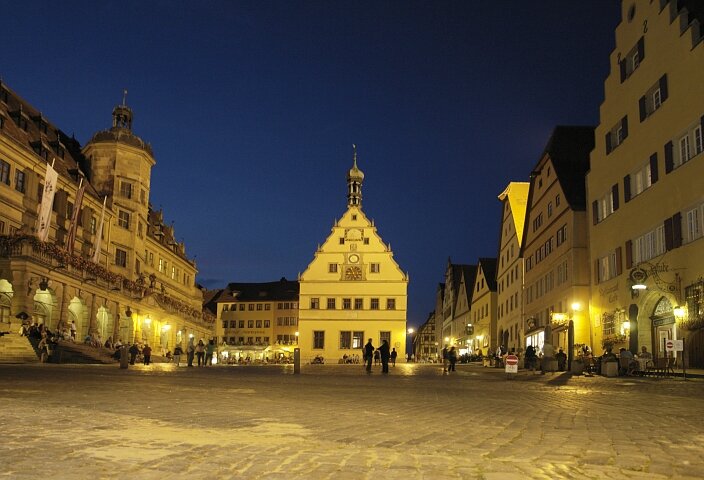 By this time we were getting the hang of getting around in Europe: a walk to the bus stop, the bus to the train station, and after a
transfer in Munich and lunch on the train, we arrived in Rothenburg.
By this time we were getting the hang of getting around in Europe: a walk to the bus stop, the bus to the train station, and after a
transfer in Munich and lunch on the train, we arrived in Rothenburg.
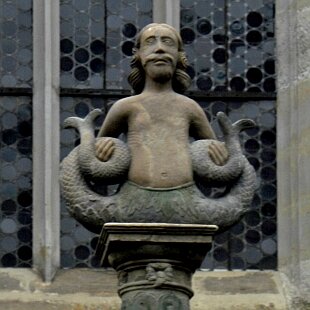 While in Rothenburg we stayed at Gasthaus Raidel, which was the most
reasonable hotel we stayed in while in Europe.
The next day we explored more of the old city, revisiting in the light of day some of the places the Night Watchman had taken us the night before.
He had told us about all the still-functioning wells in the city, and atop one we found what I can only describe as "Shakespeare as a fish?":
While in Rothenburg we stayed at Gasthaus Raidel, which was the most
reasonable hotel we stayed in while in Europe.
The next day we explored more of the old city, revisiting in the light of day some of the places the Night Watchman had taken us the night before.
He had told us about all the still-functioning wells in the city, and atop one we found what I can only describe as "Shakespeare as a fish?":
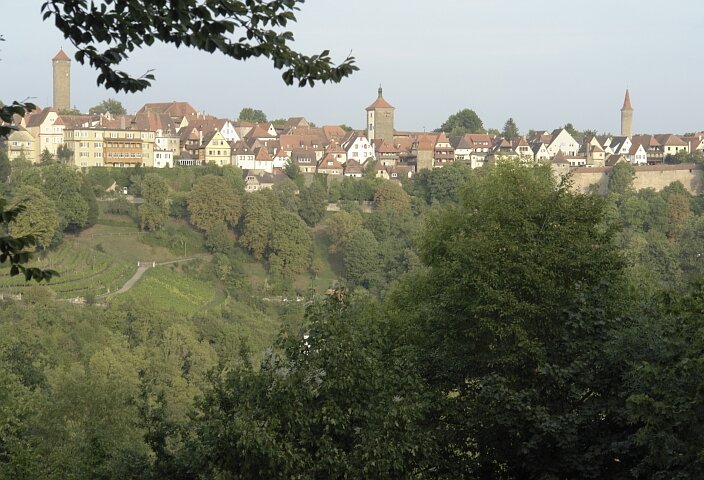 Along the way we walked two legs of the old wall, and although we did not see the southern arm of the city, this view shows a part of the
old wall.
Along the way we walked two legs of the old wall, and although we did not see the southern arm of the city, this view shows a part of the
old wall.
 We descended from the wall at the Klingentor, and there witnessed a bizarre traffic jam involving a tour bus, a couple of cars, a piece
of road machinery that barely fit through the gate, a horse-drawn carriage and a restaurant. The tour bus was trying to make the turn from
where I later took this picture:
We descended from the wall at the Klingentor, and there witnessed a bizarre traffic jam involving a tour bus, a couple of cars, a piece
of road machinery that barely fit through the gate, a horse-drawn carriage and a restaurant. The tour bus was trying to make the turn from
where I later took this picture:
into the street on the right, but couldn't turn tightly enough. The traffic behind him prevented him from backing up and trying again,
so they did the only thing possible: they dismantled the sidewalk cafe on the left so the bus could back into the restaurant,
and make a straighter approach into the street on the right. It was hilarious to watch, but reinforced a conclusion I had already
reached: it is insane to allow motorized traffic within the walls. Those streets were simply not built for tour buses and trucks!

 From the Klingentor, we walked up to St. Jakob's, which features this magnificent new organ; one of many I was to see and wish I could have heard:
From the Klingentor, we walked up to St. Jakob's, which features this magnificent new organ; one of many I was to see and wish I could have heard:
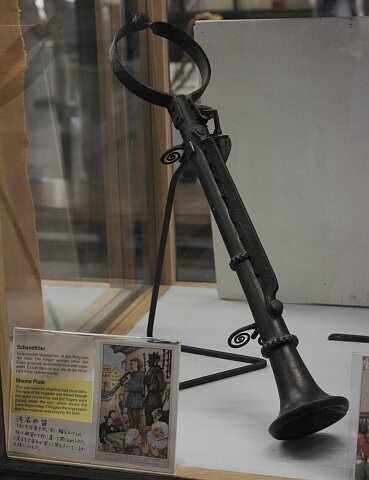 After another good lunch (we found no bad restaurants in Germany) we walked back up to the square, to the Friese Store,
where we accomplished one of the many missions
of our trip: we bought a cuckoo clock. Since we had no room for souvenirs in our luggage, we decided to buy ourselves a clock and have
it shipped home. The Friese Store will not only ship at cost, but will refund in advance the dreaded "Value Added Tax" on all goods purchased
in Germany.
After another good lunch (we found no bad restaurants in Germany) we walked back up to the square, to the Friese Store,
where we accomplished one of the many missions
of our trip: we bought a cuckoo clock. Since we had no room for souvenirs in our luggage, we decided to buy ourselves a clock and have
it shipped home. The Friese Store will not only ship at cost, but will refund in advance the dreaded "Value Added Tax" on all goods purchased
in Germany.
This was used to shame bad musicians into playing better: if you were sufficiently lousy, it was locked around your neck, and your fingers
were locked into the shaft, so that it appeared that you were doing the practicing you had obviously ignored. Knowing a few musicians,
I couldn't resist including this picture.
Dusk was falling, we were getting peckish, and for dinner this evening we decided (with apologies to Hermann Hesse) that should Harry Haller be looking for us,
"Mary and Ken would be in Hell"; more properly, Mittelalterliche Trinkstube zur Hölle:
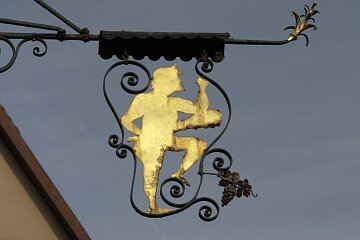 Both the food and the drink were excellent (hardly what Rick Steves called "pub food"), and we had a pleasant evening eating and waiting for
the Night Watchman to catch up with us with his flock of the evening.
Both the food and the drink were excellent (hardly what Rick Steves called "pub food"), and we had a pleasant evening eating and waiting for
the Night Watchman to catch up with us with his flock of the evening.
Eisenach
Here is where we learned what foreign means. We alighted from the train and stopped by Information. I began with my usual
"Guten Tag; sprechen sie English?" The response: "Nein." And that was the end of the conversation.
 After a half hour we gave up and hired a taxi driver (who also did not speak English) to take us there.
Finally we were saved: the Tourist Information lady spoke English and was able to find us a room.
Our luck held when we arrived at the hotel: the hostess' son spoke enough English that we could
get settled. But during our time in Eisenach, there was a lot of signing and pointing.
After a half hour we gave up and hired a taxi driver (who also did not speak English) to take us there.
Finally we were saved: the Tourist Information lady spoke English and was able to find us a room.
Our luck held when we arrived at the hotel: the hostess' son spoke enough English that we could
get settled. But during our time in Eisenach, there was a lot of signing and pointing.
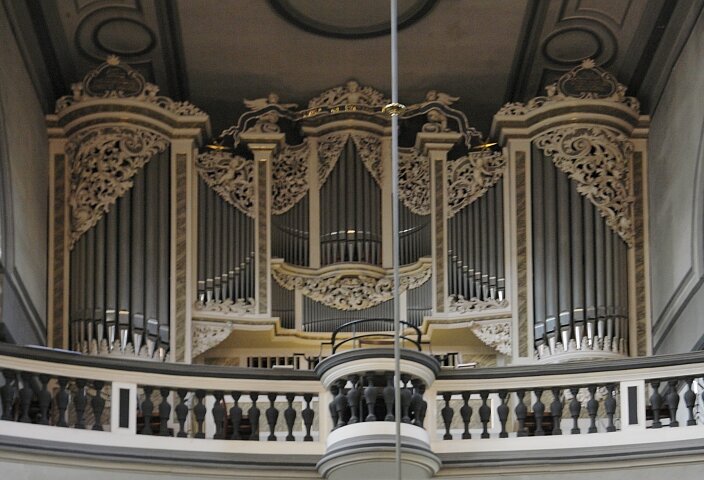 In the morning we walked over to Elisabethkirche where we heard the organist practicing. I almost scared a nun to death when I started
to take a picture of the altar and she walked behind it. We made it to Georgenkirche, where Bach was baptized, in time for the organ concert there.
It was very cool to hear Sleepers Awake performed in the church where Bach learned organ at the feet of his Uncle Johann Christoph:
In the morning we walked over to Elisabethkirche where we heard the organist practicing. I almost scared a nun to death when I started
to take a picture of the altar and she walked behind it. We made it to Georgenkirche, where Bach was baptized, in time for the organ concert there.
It was very cool to hear Sleepers Awake performed in the church where Bach learned organ at the feet of his Uncle Johann Christoph:
Walking back to the train station, we stowed our bags in a luggage locker and caught the bus to our other Eisenach destination: the Wartburg.
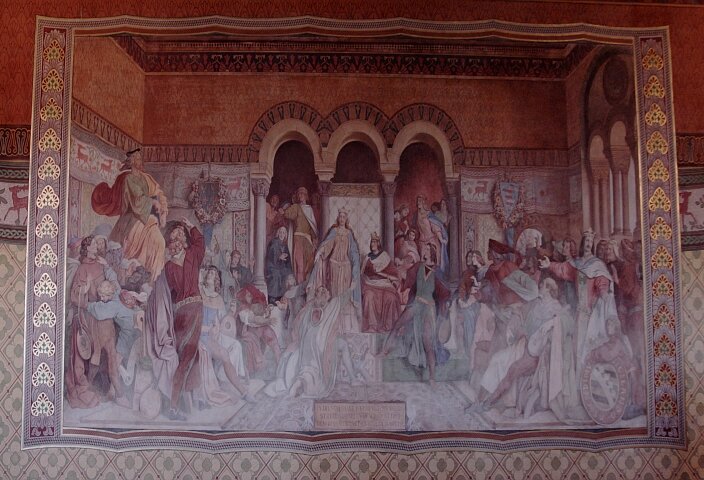 Spectacular as a work of art, the story also explained a phenomenon we had noticed in Eisenach: there are roses everywhere. Even our taxi driver had a rose
on his dashboard. Elisabeth was married to the Margrave, but liked to help the poor, and would always take food down to the town. When her
husband attempted to catch her in the act, she claimed that the basket only contained roses, and the story tells us that when he lifted the
cloth over the food basket, there were indeed roses underneath. After his death, she renounced her wealth and spent her life taking care of the
poor. Eisenach apparently has had a love affair with roses ever since, and it is a beautiful town for it.
Spectacular as a work of art, the story also explained a phenomenon we had noticed in Eisenach: there are roses everywhere. Even our taxi driver had a rose
on his dashboard. Elisabeth was married to the Margrave, but liked to help the poor, and would always take food down to the town. When her
husband attempted to catch her in the act, she claimed that the basket only contained roses, and the story tells us that when he lifted the
cloth over the food basket, there were indeed roses underneath. After his death, she renounced her wealth and spent her life taking care of the
poor. Eisenach apparently has had a love affair with roses ever since, and it is a beautiful town for it.
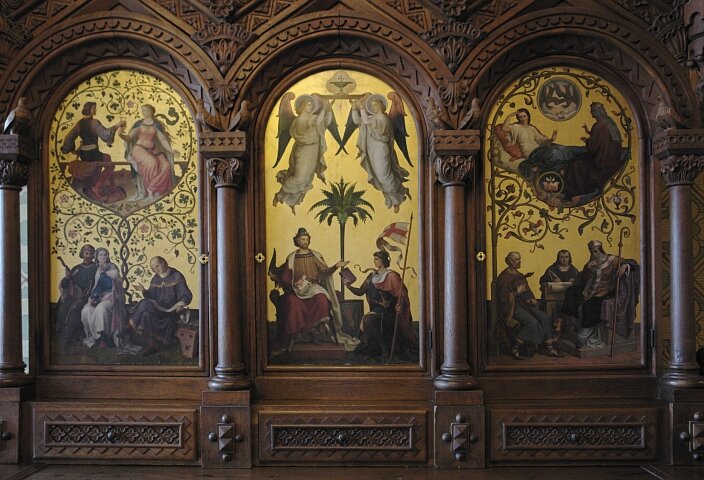 The same room has a chest with paintings depicting poets and antagonists from Tristan, The Nibelungenlied and Parsifal. On the left,
Gottfried von Strassburg reads his story to two young lovers as Tristan and Isolde look on from above; on the right we find the unknown author of
the Nibelungenlied singing his poem to his patron, Bishop Wolfger of Passau; and in the center we see Wolfram von Eschenbach with his creation
Parzival:
The same room has a chest with paintings depicting poets and antagonists from Tristan, The Nibelungenlied and Parsifal. On the left,
Gottfried von Strassburg reads his story to two young lovers as Tristan and Isolde look on from above; on the right we find the unknown author of
the Nibelungenlied singing his poem to his patron, Bishop Wolfger of Passau; and in the center we see Wolfram von Eschenbach with his creation
Parzival:
After the tour we hiked back down to the bus stop, took the bus to the train station, rescued our bags and boarded the train for...
Leipzig
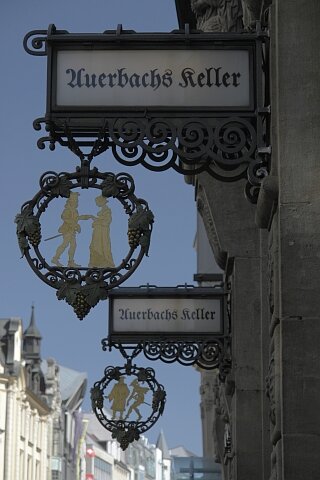 After our experiences in Eisenach, and considering that Rick Steves has never been to Leipzig
(or at least not written about it),
we were a little unsure of what to expect. Both Eisenach and Leipzig were formerly part of East Germany (the so-called German
Democratic Republic), and our train rides in those areas took us through some depressing Communist-era industrial and residential zones.
After our experiences in Eisenach, and considering that Rick Steves has never been to Leipzig
(or at least not written about it),
we were a little unsure of what to expect. Both Eisenach and Leipzig were formerly part of East Germany (the so-called German
Democratic Republic), and our train rides in those areas took us through some depressing Communist-era industrial and residential zones.
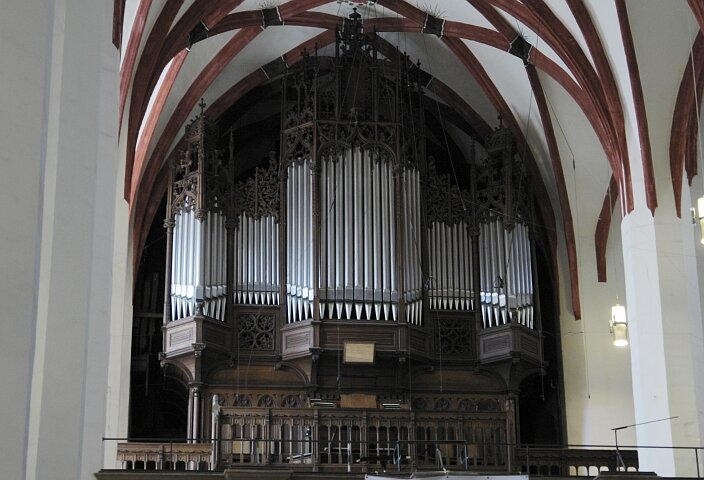 The next morning we made it to Thomaskirche in time for the service.
The Thomaskirche was my prime musical destination in Leipzig:
Bach was cantor there from 1723 until 1750, Mozart played the organ there, Mendelssohn conducted Bach there and Wagner was baptized there.
My researches on the Internet had led me to believe that the organ Bach once played was still in use there. But alas, not.
The next morning we made it to Thomaskirche in time for the service.
The Thomaskirche was my prime musical destination in Leipzig:
Bach was cantor there from 1723 until 1750, Mozart played the organ there, Mendelssohn conducted Bach there and Wagner was baptized there.
My researches on the Internet had led me to believe that the organ Bach once played was still in use there. But alas, not.
The music was about half Bach, and soprano and violin were featured as well as the organ. The congregation sang with great enthusiasm,
as one might expect in a church steeped in such a substantial musical past. It was very moving to hear Bach's music played in his church.
 This is the Bach Organ, built in 2000 by Woehl based on an organ designed by Bach's uncle Johann Christoph for the Georgenkirche in Eisenach.
It is one of a kind, tuned to the standards in use during the Baroque period. Another organ I would have loved to have heard...
This is the Bach Organ, built in 2000 by Woehl based on an organ designed by Bach's uncle Johann Christoph for the Georgenkirche in Eisenach.
It is one of a kind, tuned to the standards in use during the Baroque period. Another organ I would have loved to have heard...
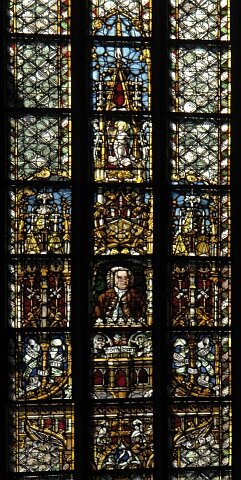
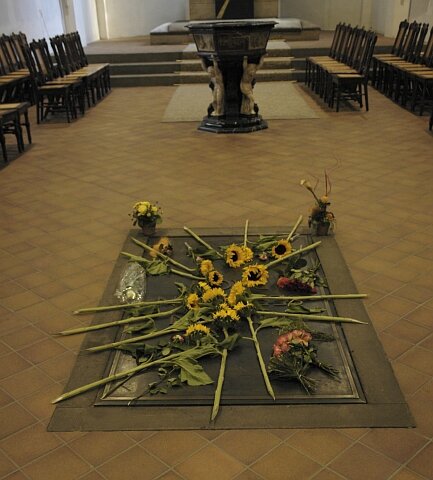 After the service, we explored the church a while. Here is the Bach Window, which shines opposite the Bach Organ, and
in the floor near the altar lies Bach himself:
After the service, we explored the church a while. Here is the Bach Window, which shines opposite the Bach Organ, and
in the floor near the altar lies Bach himself:
We wandered for a while, stopping at Zum Arabischen Coffe Baum, Europe's oldest coffee house, for a snack. Then back to the train station, which
is not only a huge rail station but also a multi-level shopping mall, for some toothpaste and soap. Then we were off to our second service of the day,
at Nikolaikirche.
 There was a very nice postlude played on this beautiful organ:
There was a very nice postlude played on this beautiful organ:
But Nikolaikirche has a story more interesting than its organ; in 1989 it was a focal point in the fall of Communism.
Bayreuth
We arrived in Bayreuth mid-afternoon, having left Leipzig
at about 8:00. Several blocks from the train station, we found the Tourist Information Bureau, with whom I had corresponded before the trip.
They were very helpful in finding us a hotel, the Goldener Hirsch,
which turned out to be almost where we had started.
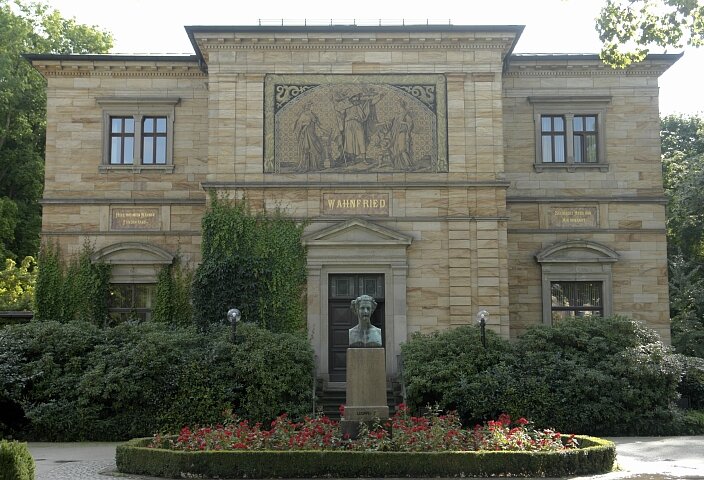 The plaques on the front read "Here where my delusions found peace, let this house be called by me 'Peace from Delusion'". The bust in front
is of Wagner's patron, King Ludwig II, and the picture over the entrance seems to me to be the Wanderer coming home. This was an image
I could identify with; with my hat slung over my back and my cane in my hand, I felt indeed like "Der Wanderer", and Bayreuth seemed
to be my musical home.
The plaques on the front read "Here where my delusions found peace, let this house be called by me 'Peace from Delusion'". The bust in front
is of Wagner's patron, King Ludwig II, and the picture over the entrance seems to me to be the Wanderer coming home. This was an image
I could identify with; with my hat slung over my back and my cane in my hand, I felt indeed like "Der Wanderer", and Bayreuth seemed
to be my musical home.
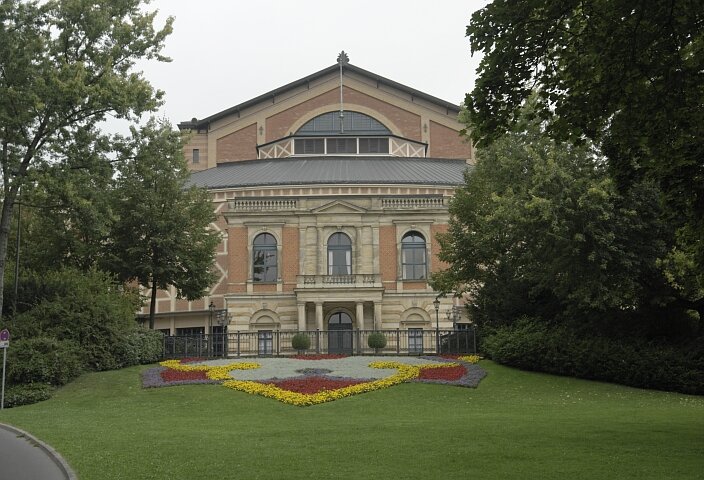 After breakfast the next morning, we took the bus to the foot of the long tree-lined drive leading up to the Festspielhaus,
home of the Richard Wagner Festival.
Even though walking was difficult, I wanted to savor the end of my journey; with the flowers still blooming it felt a
bit like climbing the rainbow bridge to Valhalla. We wandered around looking for the entrance to the tour,
prepared to be disappointed once again. How wrong you can be!
After breakfast the next morning, we took the bus to the foot of the long tree-lined drive leading up to the Festspielhaus,
home of the Richard Wagner Festival.
Even though walking was difficult, I wanted to savor the end of my journey; with the flowers still blooming it felt a
bit like climbing the rainbow bridge to Valhalla. We wandered around looking for the entrance to the tour,
prepared to be disappointed once again. How wrong you can be!
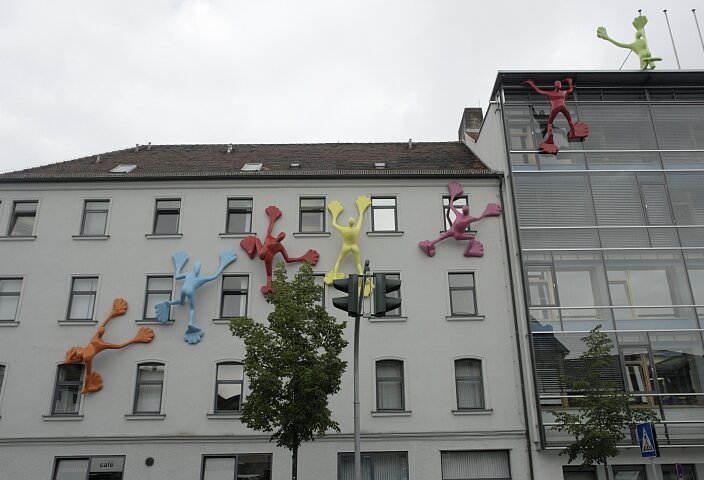 In the afternoon, after stopping for ice cream, we toured the Margrave's New Residenz. Like the Wagner Museum, this tour was self-guided; but this
time there were English handouts and we actually learned something. Filled with porcelain, paintings and an incredible set of rooms
with elaborate wall and floor and ceiling decorations, it was a very satisfying museum.
In the afternoon, after stopping for ice cream, we toured the Margrave's New Residenz. Like the Wagner Museum, this tour was self-guided; but this
time there were English handouts and we actually learned something. Filled with porcelain, paintings and an incredible set of rooms
with elaborate wall and floor and ceiling decorations, it was a very satisfying museum.
The Brenner Pass
As our train wound through the Brenner Pass, we said Goodbye to Germany and Hello to Italy. Although the exact place where one might do that
is a little unclear: for several towns and train stops, all of the signs (including the name of the town) were in both German and Italian. But
after a while there were two unmistakable signs we were in Italy: the German signs disappeared, and the countryside was juicy. Everywhere
you looked were grape vines, olive groves, fruit trees.
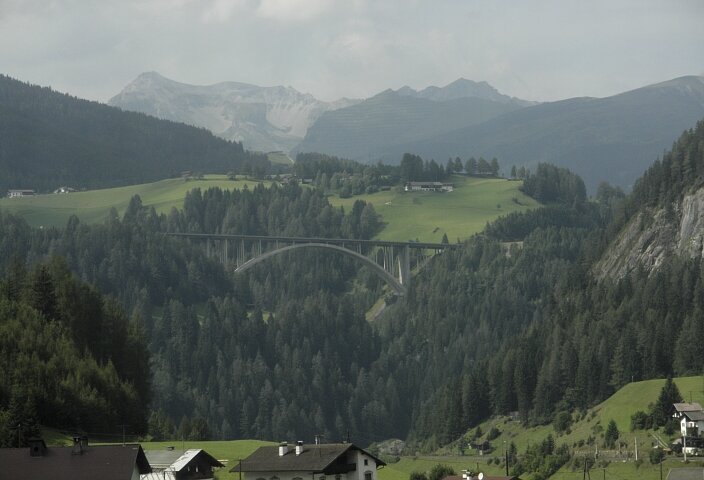
Venice
 Venice is a perfect example of my Italian paradox: while we were there I found it hot, crowded and expensive. As I look at my pictures, I think
"what a gorgeous place!"
Venice is a perfect example of my Italian paradox: while we were there I found it hot, crowded and expensive. As I look at my pictures, I think
"what a gorgeous place!"
Montepulciano
Here is where we get to meet up with Carol and Rick again, and hear about their adventures in Rothenburg, Ihlendorf, Vechta, Rome and Orvietto.
But first I have to remember how to drive a car! Of course, nothing in the U.S. can prepare you for driving in Italy...
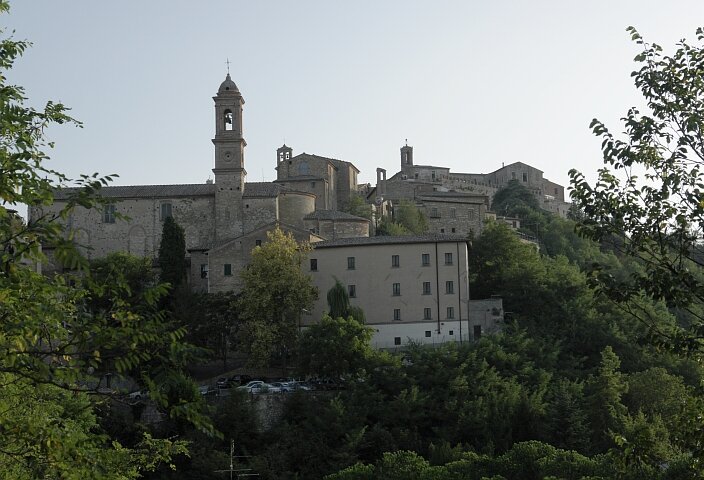 But we survived our first outing on the Autostrada, complete with gas, food and a short bottle of wine at the Autogrill. There were lots of tunnels
on the Autostrada, and a ton of gorgeous views, but nowhere to stop and take a picture. We arrived mid-afternoon
at our bed and breakfast in Montepulciano, just 15 minutes after Rick and Carol.
As we sat in the garden catching up, I was introduced to one of the great mysteries of Tuscany: where do all the mosquitoes come from
when it is so dry? I got chewed up, and kept getting chewed during our entire stay. By the time we bid the Tuscan sun goodbye, I had
over 50 bites, most still itching.
But we survived our first outing on the Autostrada, complete with gas, food and a short bottle of wine at the Autogrill. There were lots of tunnels
on the Autostrada, and a ton of gorgeous views, but nowhere to stop and take a picture. We arrived mid-afternoon
at our bed and breakfast in Montepulciano, just 15 minutes after Rick and Carol.
As we sat in the garden catching up, I was introduced to one of the great mysteries of Tuscany: where do all the mosquitoes come from
when it is so dry? I got chewed up, and kept getting chewed during our entire stay. By the time we bid the Tuscan sun goodbye, I had
over 50 bites, most still itching.
Chianti
They were flying into Rome, and we had arranged to meet them in Montevarchi, a small town on the rail line between Rome and Florence. The plan
was that they would get a phone card and call us when they got to the Rome train station, so that we would know when to expect them. We
drove to Montevarchi, arriving a little after noon, and after finding the train station and wandering a bit, we had some lunch. We had expected
to hear from them by now, but optimism won out and we returned to the train station to see if they were on the 2:11 from Rome.
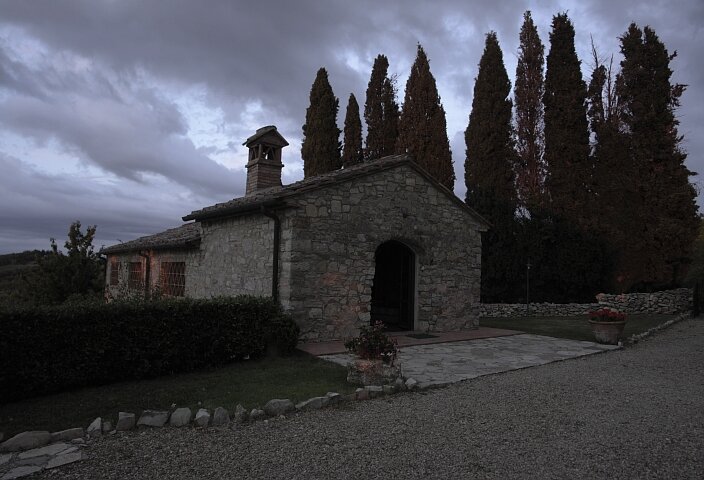 This was the road from hell! 0.8 kilometers (about half a mile) of gravel road, almost all up hill, with long ruts the width of your head.
It had 4 switchbacks and was really just one lane, although as we later learned, two cars do fit side by side (if you close your eyes).
Our best time up the road was just under 4 minutes, which means top speed is less than 8 miles per hour. And you really have to just hit
it on a run and keep going, because if you have to stop, you're going to stall your car at least once starting up it again. Richard
made a video (98 MB) with his digital camera on our last trip up so you can see what I mean.
This was the road from hell! 0.8 kilometers (about half a mile) of gravel road, almost all up hill, with long ruts the width of your head.
It had 4 switchbacks and was really just one lane, although as we later learned, two cars do fit side by side (if you close your eyes).
Our best time up the road was just under 4 minutes, which means top speed is less than 8 miles per hour. And you really have to just hit
it on a run and keep going, because if you have to stop, you're going to stall your car at least once starting up it again. Richard
made a video (98 MB) with his digital camera on our last trip up so you can see what I mean.
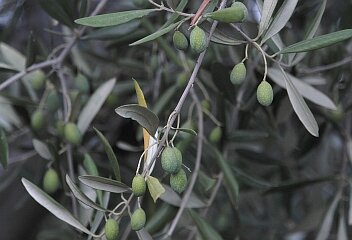 We did indeed make it back down, and back up and down 6 more times; but we never really got used to it, and never attempted it after dark.
This of course put a real cramp in our lifestyle, because none of the restaurants open much before then! So we ended up cooking more
than we expected, but it was nice to have everyone in one place, eating good food and drinking good wine at a more than leisurely pace.
We did indeed make it back down, and back up and down 6 more times; but we never really got used to it, and never attempted it after dark.
This of course put a real cramp in our lifestyle, because none of the restaurants open much before then! So we ended up cooking more
than we expected, but it was nice to have everyone in one place, eating good food and drinking good wine at a more than leisurely pace.
After dinner and dishes we did the usual laundry, and I did battle (as I would for the remainder of our stay in Chianti) with the airline
and the cell phone and the travel insurance company (who were actually very helpful). And as luck would have it, Giana told me that
the road would be fixed soon; just a month after we would be leaving!
Siena
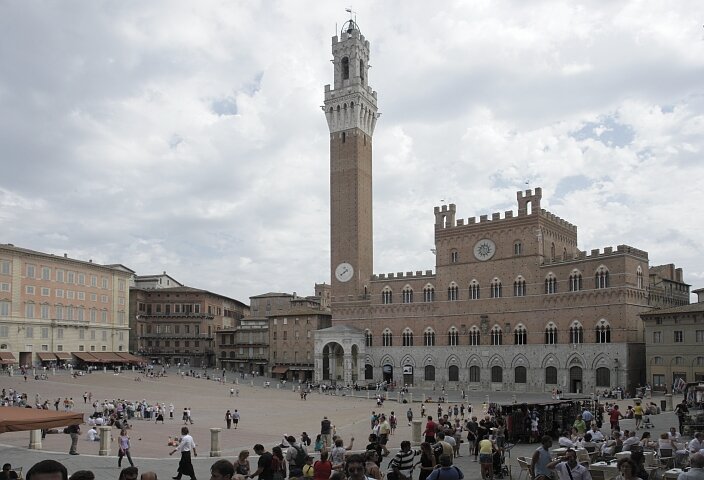 Our first day trip in Tuscany was to Siena. Following Rick Steves' directions, we parked in the Fortezza lot and walked into the old town.
We explored the Benedictine Church of St. Catherine, which contains some anatomical relics: her mummified finger and head! This was not the first
time we had encountered body parts of the saints: in Padua we had seen St. Anthonio's tongue, jaw bone and vocal chords. The faithful find
this inspiring, I suppose, but I found it a little unsettling.
Our first day trip in Tuscany was to Siena. Following Rick Steves' directions, we parked in the Fortezza lot and walked into the old town.
We explored the Benedictine Church of St. Catherine, which contains some anatomical relics: her mummified finger and head! This was not the first
time we had encountered body parts of the saints: in Padua we had seen St. Anthonio's tongue, jaw bone and vocal chords. The faithful find
this inspiring, I suppose, but I found it a little unsettling.
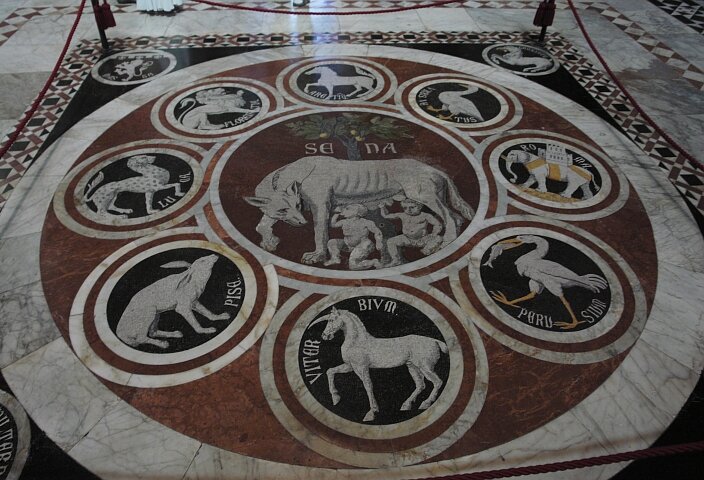 Then it was off to the Duomo, which featured 4 organs and a music library with a magnificent ceiling. But the floors here are as interesting as the ceilings:
Then it was off to the Duomo, which featured 4 organs and a music library with a magnificent ceiling. But the floors here are as interesting as the ceilings:
We walked back to the square for lunch and some musical entertainment from a local marching band, then went grocery shopping at the co-op
and made our way back up the hill before nightfall. We spent the evening snacking and enjoying the wine we bought, and making friends with
2 local cats who seemed to feel like they owned the place; which I guess they did! Took some pictures of a pretty sunset courtesy of the regional pollution
(Tuscany was a very hazy place) and then it was off to bed.
Greve
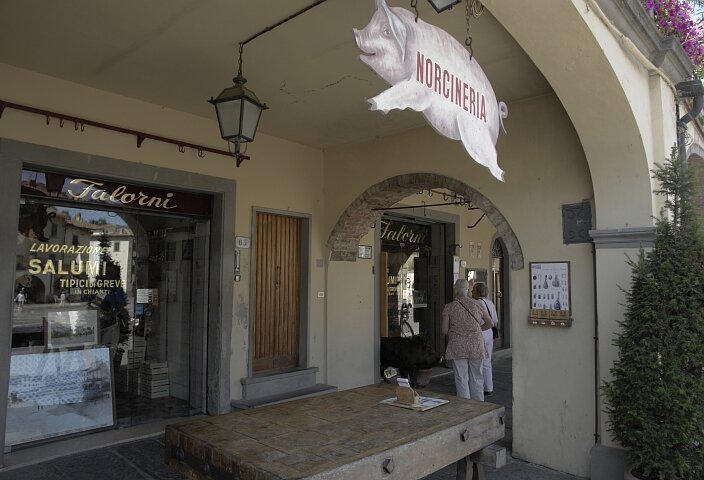 We had intended to drive to Prato for the Festival of the Virgin's Girdle, but driving in Italy had already begun to take its toll, and we just
didn't feel like it would be possible to make it there and back before sundown with the scanty amount of information we had. So instead we decided to
visit Greve, which is in some sense the "center" of Chianti. Of course the Tourist Information Bureau was closed for the holiday, which is the one
time you would think they would be open for the tourists! So we wandered around the square, visiting an amazing butcher's shop:
We had intended to drive to Prato for the Festival of the Virgin's Girdle, but driving in Italy had already begun to take its toll, and we just
didn't feel like it would be possible to make it there and back before sundown with the scanty amount of information we had. So instead we decided to
visit Greve, which is in some sense the "center" of Chianti. Of course the Tourist Information Bureau was closed for the holiday, which is the one
time you would think they would be open for the tourists! So we wandered around the square, visiting an amazing butcher's shop:
Need some wild boar salami? They've got it; it's a regional favorite.
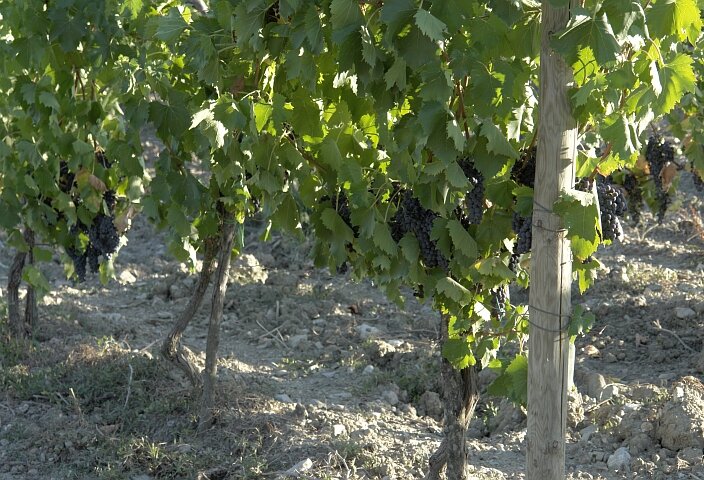 For a small fee they give you a delightful tour of the winery and tastes of all their products. We learned that DOCG Chianti Classico is
geographically limited, from young Sangiovese vines, aged in large casks for a relatively short time; it has a correspondingly short life. Chianti Classico
Reserva (which has a very delicate nose and is very smooth) is from old vines, aged in smaller casks for a longer period; it has a longer lifespan.
Supertuscans (denoted IGT) are less than 80% Sangiovese, with most of the character coming from the Cabernet Sauvignon and/or Merlot components.
Sangiovese grows so tightly that they pull some off prematurely to let the air circulate around the grapes; that's why we saw so many grapes on the
ground. Those are left a small distance from the vines to avoid off flavors from the decaying grapes.
For a small fee they give you a delightful tour of the winery and tastes of all their products. We learned that DOCG Chianti Classico is
geographically limited, from young Sangiovese vines, aged in large casks for a relatively short time; it has a correspondingly short life. Chianti Classico
Reserva (which has a very delicate nose and is very smooth) is from old vines, aged in smaller casks for a longer period; it has a longer lifespan.
Supertuscans (denoted IGT) are less than 80% Sangiovese, with most of the character coming from the Cabernet Sauvignon and/or Merlot components.
Sangiovese grows so tightly that they pull some off prematurely to let the air circulate around the grapes; that's why we saw so many grapes on the
ground. Those are left a small distance from the vines to avoid off flavors from the decaying grapes.
Assisi
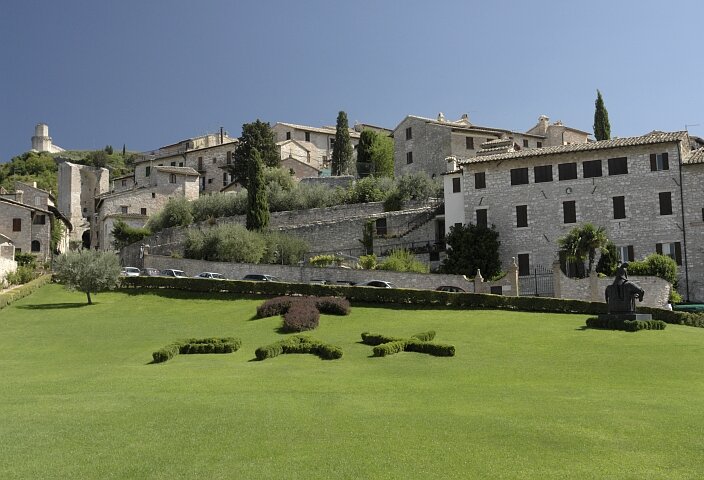 Assisi is in Umbria, and was a several hour drive. It is actually shorter time-wise to drive up to Florence and then
back down the Autostrata to Perugia on the way. We parked near the train station and took a bus up to the old town, then walked up to the
Cathedral of St. Francis. We saw the tomb, the relics, the museum and both the upper and lower churches. I've decided that frescoes are
really not my thing, but the marble and the stained glass were nice, and the organ was interesting.
Outside the upper church there was a lovely green with an equally lovely message from St. Francis:
Assisi is in Umbria, and was a several hour drive. It is actually shorter time-wise to drive up to Florence and then
back down the Autostrata to Perugia on the way. We parked near the train station and took a bus up to the old town, then walked up to the
Cathedral of St. Francis. We saw the tomb, the relics, the museum and both the upper and lower churches. I've decided that frescoes are
really not my thing, but the marble and the stained glass were nice, and the organ was interesting.
Outside the upper church there was a lovely green with an equally lovely message from St. Francis:
Inside the church we were treated to a Python-esque
moment. As with all of the churches in Italy, there was a sign asking you to be quiet; very reasonable, and yet some folks just couldn't
hold it down. And whenever someone talked a little too loudly, there was a crashing "SILENCIO! SHHHHHHHHHH!" from the speakers; vastly
more loud and disturbing than anything anyone had said. But no one seemed to appreciate the absurdity of the situation, and I couldn't decide whether
the speaker was just over-zealous, or if he enjoyed playing the part of God.
San Gimignano
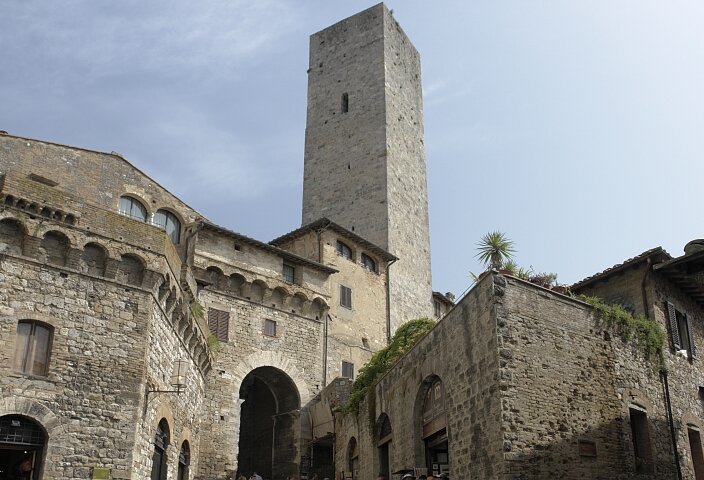 A very picturesque place from a distance, San Gimignano up close in September is a hot, crowded tourist trap. But it has at least
one redeeming feature: Gelaterria di Piazza, one of the great gelato shops of the world. More of everything gelato should be: intense
flavors, thick and yet creamy, and somehow much more satisfying than ice cream, even though it has less fat.
A very picturesque place from a distance, San Gimignano up close in September is a hot, crowded tourist trap. But it has at least
one redeeming feature: Gelaterria di Piazza, one of the great gelato shops of the world. More of everything gelato should be: intense
flavors, thick and yet creamy, and somehow much more satisfying than ice cream, even though it has less fat.
Florence
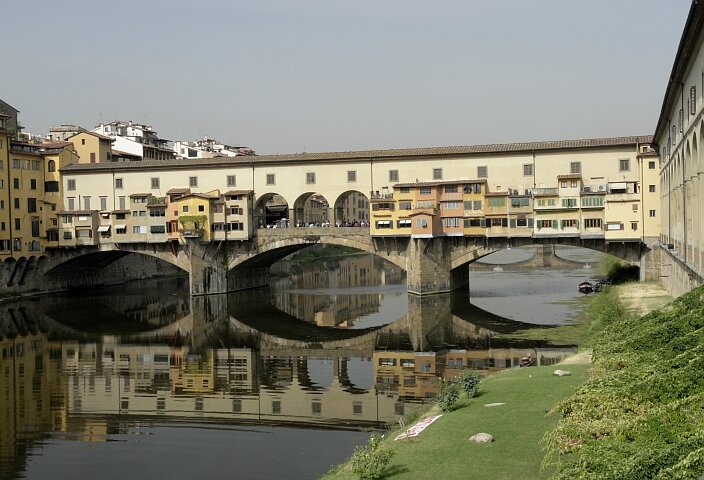 Richard had done yeoman's work on the phone the other day getting us reservations for the Uffizi and the Accademia, so we had a quick
breakfast and drove into Florence. Scenes like the Ponte Vecchio here make Florence seem fetching:
Richard had done yeoman's work on the phone the other day getting us reservations for the Uffizi and the Accademia, so we had a quick
breakfast and drove into Florence. Scenes like the Ponte Vecchio here make Florence seem fetching:
but I found it hot and dirty and crowded. We ended up parking in Alberti (a mistake) and taking the bus into the old town.
You don't want to be caught driving there unless you have a special permit, and there were still too many cars. And you have to buy
your bus tickets at the tobacconist's; otherwise you pay double!
Pisa
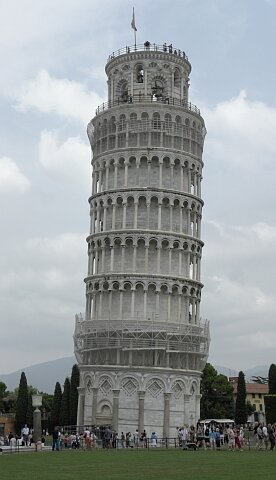 The Tuscan calenders do nothing to prepare you for the horror that is Italy. I had planned a nice rural sequence of towns to drive through on the way to Pisa.
But after a series of one-horse... towns, with one-way streets that change direction on a traffic light and come equipped with a vagrant with
dirty water and a squeegee who expects to get paid for messing up your windshield even though you vigorously shake your head "NO!" and honk at him...
We finally got on the Fi-Pi-Li (Firenza-Pisa-Livorno expressway) and made some time.
The Tuscan calenders do nothing to prepare you for the horror that is Italy. I had planned a nice rural sequence of towns to drive through on the way to Pisa.
But after a series of one-horse... towns, with one-way streets that change direction on a traffic light and come equipped with a vagrant with
dirty water and a squeegee who expects to get paid for messing up your windshield even though you vigorously shake your head "NO!" and honk at him...
We finally got on the Fi-Pi-Li (Firenza-Pisa-Livorno expressway) and made some time.
OK, so now you've seen it, take my advice and pass up Pisa.
Corniglia
Richard was invaluable in finding the rental car office in Florence; he told me each time where to turn because I had my hands full
avoiding accidents. Our poor Punto was not the car it had been a week before; between 7 trips up and down the "dirty road", and the hail
storm (which left little dents all over it), it needed a front-end alignment and some body work. I was impressed with it, though: it got
almost 39 miles to the gallon!
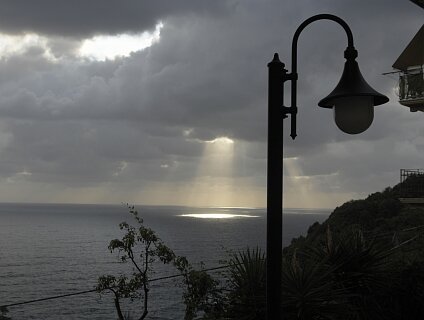 Of course, with the rail strike we tried to
keep it for an extra day, but it was already rented; by the time we left the garage they were already washing it for the next customer.
And of course there were no other cars available... But at the train station we found a very patient and helpful
FS (Ferrovie dello Stato) employee
who saved our bacon: there was one train running out of Tuscany, and if we could go to Rome and then catch a train to La Spezia, we
could make it to Cinque Terra.
Of course, with the rail strike we tried to
keep it for an extra day, but it was already rented; by the time we left the garage they were already washing it for the next customer.
And of course there were no other cars available... But at the train station we found a very patient and helpful
FS (Ferrovie dello Stato) employee
who saved our bacon: there was one train running out of Tuscany, and if we could go to Rome and then catch a train to La Spezia, we
could make it to Cinque Terra.
Dinner featured the best pesto we had ever eaten, and the local white wine. I typically don't go in for whites, but this had a great deal of
character; almost golden, with a hint of raisin, and nice body. We ate al fresco overlooking the Mediterranean despite the strong breeze;
I would take a jacket with me on the morrow!
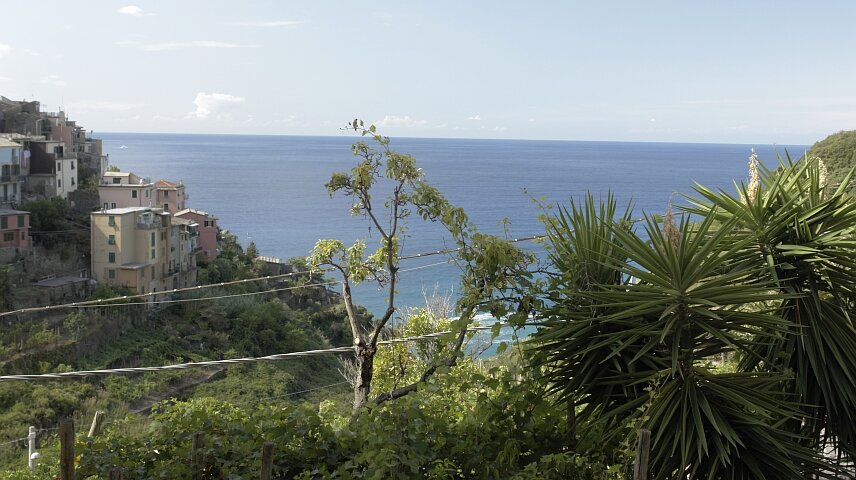
Riomaggiore
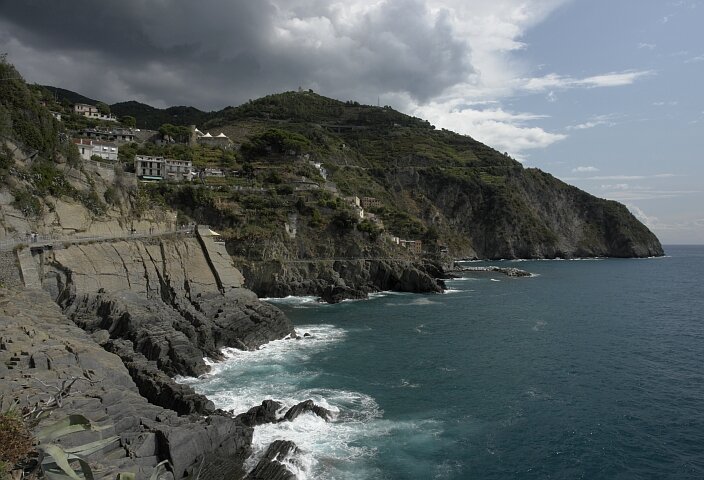 Our card was good for the lift, so we took it up to see the view and take some pictures. The vegetation seemed strange: cacti all over,
sharing space with marigolds and grape vines. The shoreline all along the Cinque Terra is rocky, very picturesque with lots of foam.
Our card was good for the lift, so we took it up to see the view and take some pictures. The vegetation seemed strange: cacti all over,
sharing space with marigolds and grape vines. The shoreline all along the Cinque Terra is rocky, very picturesque with lots of foam.
Manarola
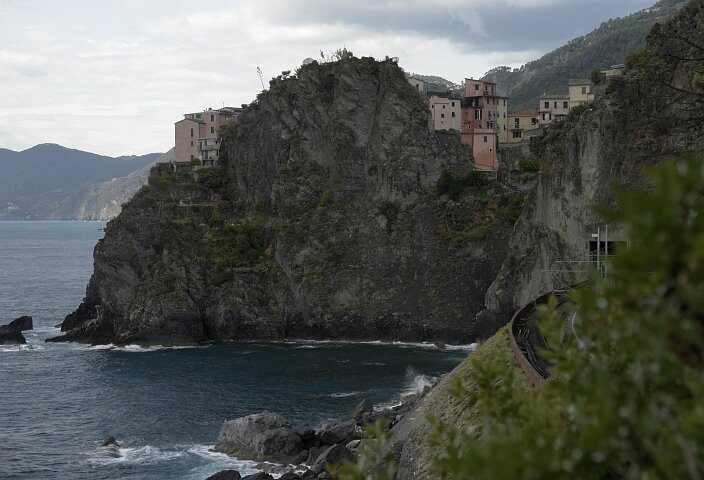 Three quarters of the way to Manarola a storm blew up, and we were just arriving at a little cafe on the side of the cliff. So we stopped
for a beer and a bruschetta, and when we were finished the storm was just passing.
Three quarters of the way to Manarola a storm blew up, and we were just arriving at a little cafe on the side of the cliff. So we stopped
for a beer and a bruschetta, and when we were finished the storm was just passing.
Vernazza
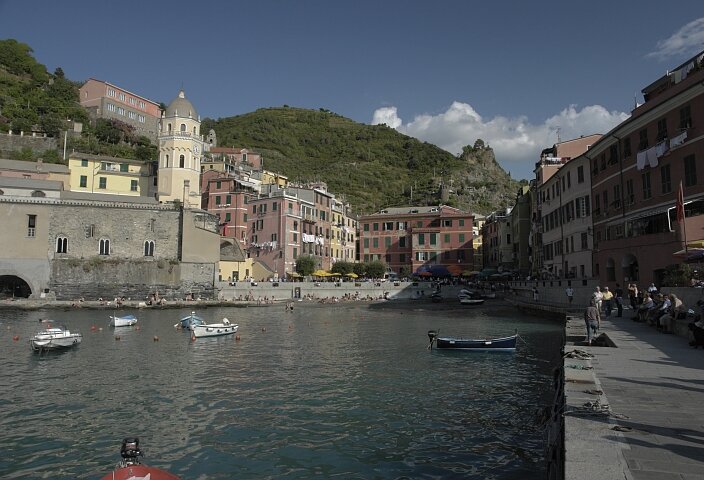 We took the train to Vernazza and wandered around a bit, but I found it too crowded and too touristy. If you head up the hill, away
from the sea, it thins out a bit and there are some great views.
We took the train to Vernazza and wandered around a bit, but I found it too crowded and too touristy. If you head up the hill, away
from the sea, it thins out a bit and there are some great views.
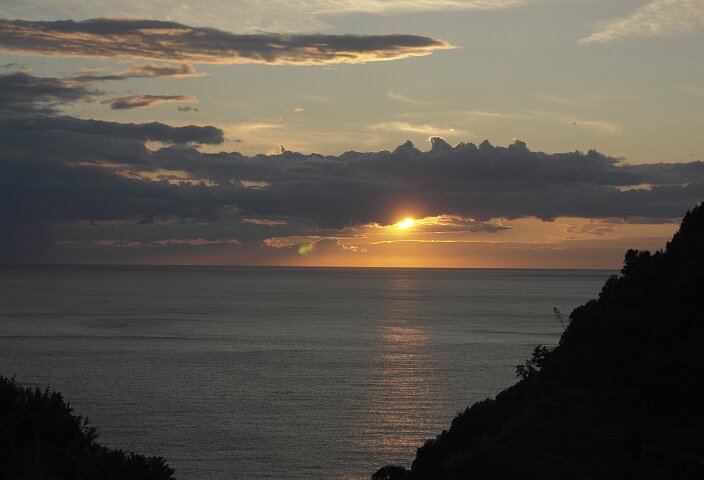 We had another lovely sunset in Corniglia before we started our journey home. We took the train to Milan, and I found it odd that after
Genoa (which is a big city), the countryside became flat. Upon arriving in Milan, we walked the length of the train station 3 times
trying to find the WC (bathrooms), Tourist Information, bus tickets and the bus stop (which was hidden behind the taxi stand).
There was a lot of construction, but the signage also left a lot to be desired.
We had another lovely sunset in Corniglia before we started our journey home. We took the train to Milan, and I found it odd that after
Genoa (which is a big city), the countryside became flat. Upon arriving in Milan, we walked the length of the train station 3 times
trying to find the WC (bathrooms), Tourist Information, bus tickets and the bus stop (which was hidden behind the taxi stand).
There was a lot of construction, but the signage also left a lot to be desired.
On the way home
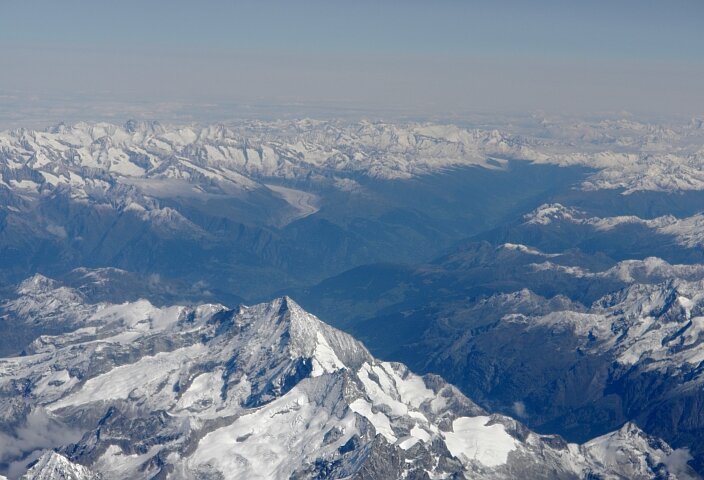 But I couldn't resist a parting shot at the Swiss Alps as we flew over them on our way to JFK. When we finally got home, we found
that after a major wind storm two days before, our electricity had just come back on, and while we had half a tree down in our back yard
and water damage on our kitchen floor (on the next trip I will empty the ice maker and turn it off!), it was great to be home.
But I couldn't resist a parting shot at the Swiss Alps as we flew over them on our way to JFK. When we finally got home, we found
that after a major wind storm two days before, our electricity had just come back on, and while we had half a tree down in our back yard
and water damage on our kitchen floor (on the next trip I will empty the ice maker and turn it off!), it was great to be home.
Final thoughts...
I suppose you could be forgiven if you got the impression that I did not like Italy.
The essence of Italy is chaos, and the orderly part of me, much in the majority, preferred the way things are done in Germany and Austria.
But while there were ups and downs, it was all a wonderful adventure.